Sepsis Management: Critical Discussion on Case Study, NSN721 Essay
VerifiedAdded on 2022/08/18
|17
|4773
|22
Essay
AI Summary
This essay delves into the multifaceted aspects of sepsis management, beginning with an overview of sepsis and its prevalence. The essay then explores the pathophysiology of sepsis, examining the inflammatory and immune responses, endothelial barrier dysfunction, and coagulation processes. A detailed case study of a 52-year-old man admitted to the emergency department after an accident is analyzed, highlighting the progression of sepsis and the clinical challenges encountered. The essay further discusses the management of sepsis, including resuscitation strategies, appropriate antimicrobial therapy, and the importance of early goal-directed therapy. It references key research and guidelines, emphasizing the critical need for prompt recognition, and comprehensive patient care, and the significance of understanding the evolving nature of sepsis to improve patient outcomes. The essay highlights the impact of sepsis on patient morbidity and mortality, underscoring the importance of evidence-based practices in the treatment of this life-threatening condition.
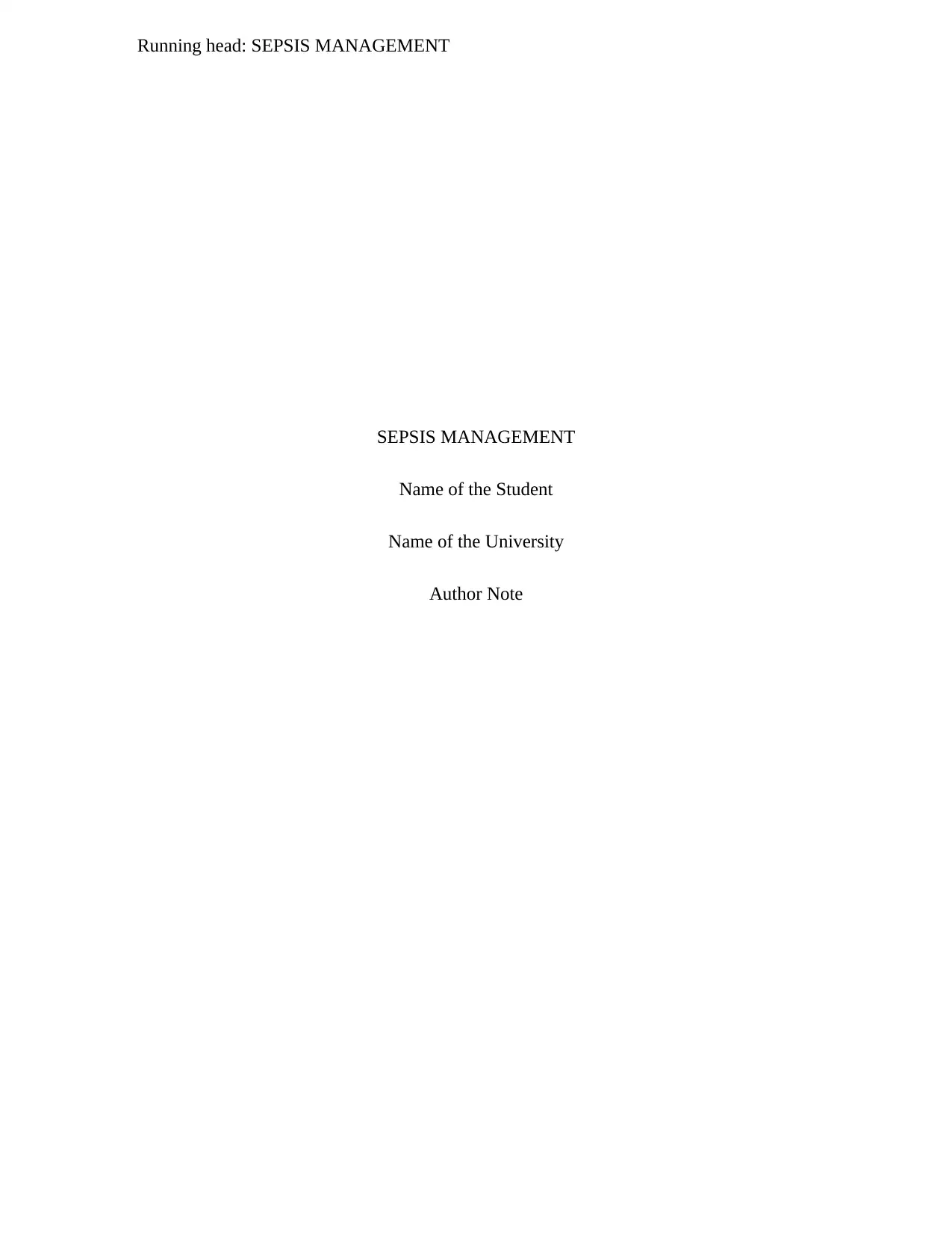
Running head: SEPSIS MANAGEMENT
SEPSIS MANAGEMENT
Name of the Student
Name of the University
Author Note
SEPSIS MANAGEMENT
Name of the Student
Name of the University
Author Note
Secure Best Marks with AI Grader
Need help grading? Try our AI Grader for instant feedback on your assignments.
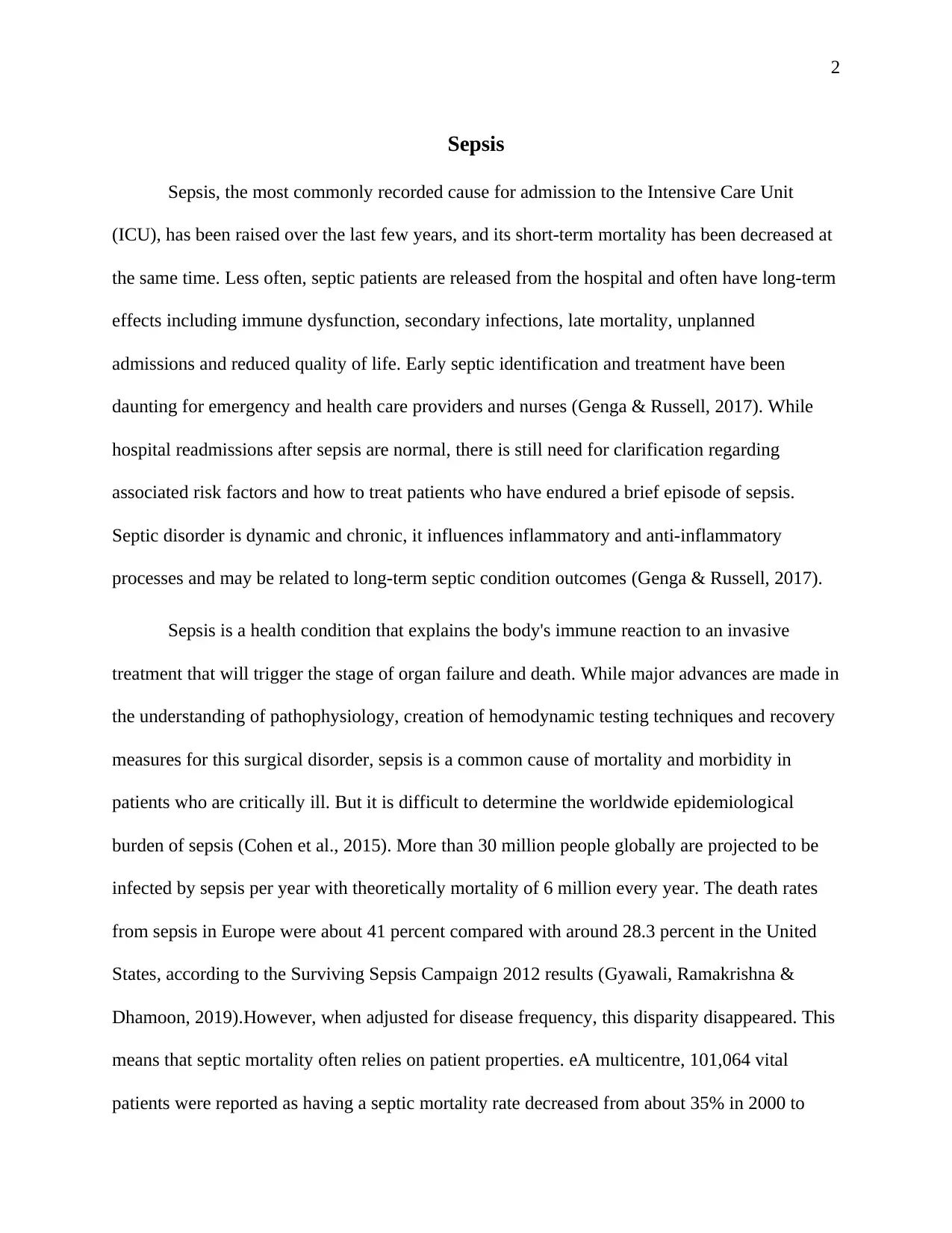
2
Sepsis
Sepsis, the most commonly recorded cause for admission to the Intensive Care Unit
(ICU), has been raised over the last few years, and its short-term mortality has been decreased at
the same time. Less often, septic patients are released from the hospital and often have long-term
effects including immune dysfunction, secondary infections, late mortality, unplanned
admissions and reduced quality of life. Early septic identification and treatment have been
daunting for emergency and health care providers and nurses (Genga & Russell, 2017). While
hospital readmissions after sepsis are normal, there is still need for clarification regarding
associated risk factors and how to treat patients who have endured a brief episode of sepsis.
Septic disorder is dynamic and chronic, it influences inflammatory and anti-inflammatory
processes and may be related to long-term septic condition outcomes (Genga & Russell, 2017).
Sepsis is a health condition that explains the body's immune reaction to an invasive
treatment that will trigger the stage of organ failure and death. While major advances are made in
the understanding of pathophysiology, creation of hemodynamic testing techniques and recovery
measures for this surgical disorder, sepsis is a common cause of mortality and morbidity in
patients who are critically ill. But it is difficult to determine the worldwide epidemiological
burden of sepsis (Cohen et al., 2015). More than 30 million people globally are projected to be
infected by sepsis per year with theoretically mortality of 6 million every year. The death rates
from sepsis in Europe were about 41 percent compared with around 28.3 percent in the United
States, according to the Surviving Sepsis Campaign 2012 results (Gyawali, Ramakrishna &
Dhamoon, 2019).However, when adjusted for disease frequency, this disparity disappeared. This
means that septic mortality often relies on patient properties. eA multicentre, 101,064 vital
patients were reported as having a septic mortality rate decreased from about 35% in 2000 to
Sepsis
Sepsis, the most commonly recorded cause for admission to the Intensive Care Unit
(ICU), has been raised over the last few years, and its short-term mortality has been decreased at
the same time. Less often, septic patients are released from the hospital and often have long-term
effects including immune dysfunction, secondary infections, late mortality, unplanned
admissions and reduced quality of life. Early septic identification and treatment have been
daunting for emergency and health care providers and nurses (Genga & Russell, 2017). While
hospital readmissions after sepsis are normal, there is still need for clarification regarding
associated risk factors and how to treat patients who have endured a brief episode of sepsis.
Septic disorder is dynamic and chronic, it influences inflammatory and anti-inflammatory
processes and may be related to long-term septic condition outcomes (Genga & Russell, 2017).
Sepsis is a health condition that explains the body's immune reaction to an invasive
treatment that will trigger the stage of organ failure and death. While major advances are made in
the understanding of pathophysiology, creation of hemodynamic testing techniques and recovery
measures for this surgical disorder, sepsis is a common cause of mortality and morbidity in
patients who are critically ill. But it is difficult to determine the worldwide epidemiological
burden of sepsis (Cohen et al., 2015). More than 30 million people globally are projected to be
infected by sepsis per year with theoretically mortality of 6 million every year. The death rates
from sepsis in Europe were about 41 percent compared with around 28.3 percent in the United
States, according to the Surviving Sepsis Campaign 2012 results (Gyawali, Ramakrishna &
Dhamoon, 2019).However, when adjusted for disease frequency, this disparity disappeared. This
means that septic mortality often relies on patient properties. eA multicentre, 101,064 vital
patients were reported as having a septic mortality rate decreased from about 35% in 2000 to
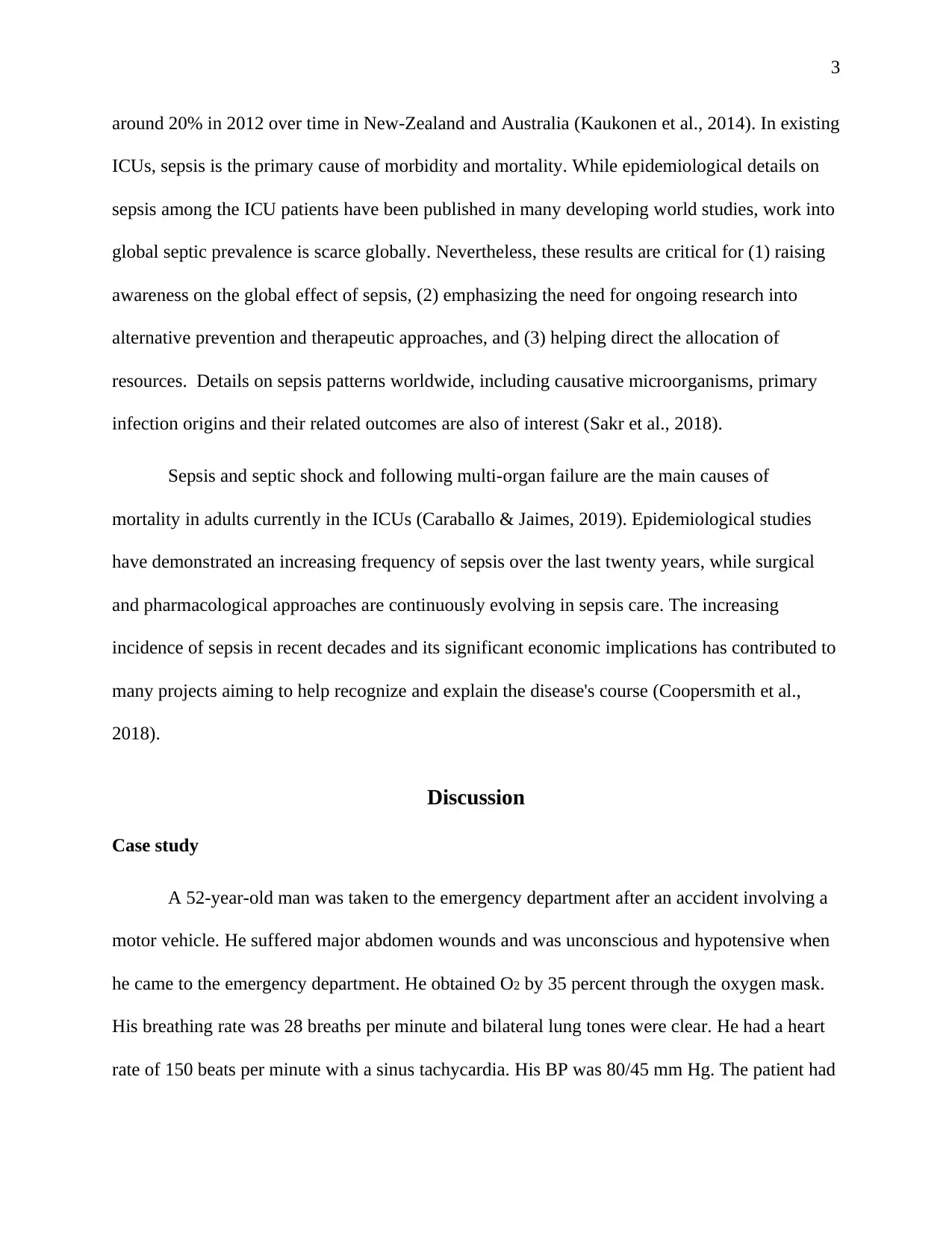
3
around 20% in 2012 over time in New-Zealand and Australia (Kaukonen et al., 2014). In existing
ICUs, sepsis is the primary cause of morbidity and mortality. While epidemiological details on
sepsis among the ICU patients have been published in many developing world studies, work into
global septic prevalence is scarce globally. Nevertheless, these results are critical for (1) raising
awareness on the global effect of sepsis, (2) emphasizing the need for ongoing research into
alternative prevention and therapeutic approaches, and (3) helping direct the allocation of
resources. Details on sepsis patterns worldwide, including causative microorganisms, primary
infection origins and their related outcomes are also of interest (Sakr et al., 2018).
Sepsis and septic shock and following multi-organ failure are the main causes of
mortality in adults currently in the ICUs (Caraballo & Jaimes, 2019). Epidemiological studies
have demonstrated an increasing frequency of sepsis over the last twenty years, while surgical
and pharmacological approaches are continuously evolving in sepsis care. The increasing
incidence of sepsis in recent decades and its significant economic implications has contributed to
many projects aiming to help recognize and explain the disease's course (Coopersmith et al.,
2018).
Discussion
Case study
A 52-year-old man was taken to the emergency department after an accident involving a
motor vehicle. He suffered major abdomen wounds and was unconscious and hypotensive when
he came to the emergency department. He obtained O2 by 35 percent through the oxygen mask.
His breathing rate was 28 breaths per minute and bilateral lung tones were clear. He had a heart
rate of 150 beats per minute with a sinus tachycardia. His BP was 80/45 mm Hg. The patient had
around 20% in 2012 over time in New-Zealand and Australia (Kaukonen et al., 2014). In existing
ICUs, sepsis is the primary cause of morbidity and mortality. While epidemiological details on
sepsis among the ICU patients have been published in many developing world studies, work into
global septic prevalence is scarce globally. Nevertheless, these results are critical for (1) raising
awareness on the global effect of sepsis, (2) emphasizing the need for ongoing research into
alternative prevention and therapeutic approaches, and (3) helping direct the allocation of
resources. Details on sepsis patterns worldwide, including causative microorganisms, primary
infection origins and their related outcomes are also of interest (Sakr et al., 2018).
Sepsis and septic shock and following multi-organ failure are the main causes of
mortality in adults currently in the ICUs (Caraballo & Jaimes, 2019). Epidemiological studies
have demonstrated an increasing frequency of sepsis over the last twenty years, while surgical
and pharmacological approaches are continuously evolving in sepsis care. The increasing
incidence of sepsis in recent decades and its significant economic implications has contributed to
many projects aiming to help recognize and explain the disease's course (Coopersmith et al.,
2018).
Discussion
Case study
A 52-year-old man was taken to the emergency department after an accident involving a
motor vehicle. He suffered major abdomen wounds and was unconscious and hypotensive when
he came to the emergency department. He obtained O2 by 35 percent through the oxygen mask.
His breathing rate was 28 breaths per minute and bilateral lung tones were clear. He had a heart
rate of 150 beats per minute with a sinus tachycardia. His BP was 80/45 mm Hg. The patient had
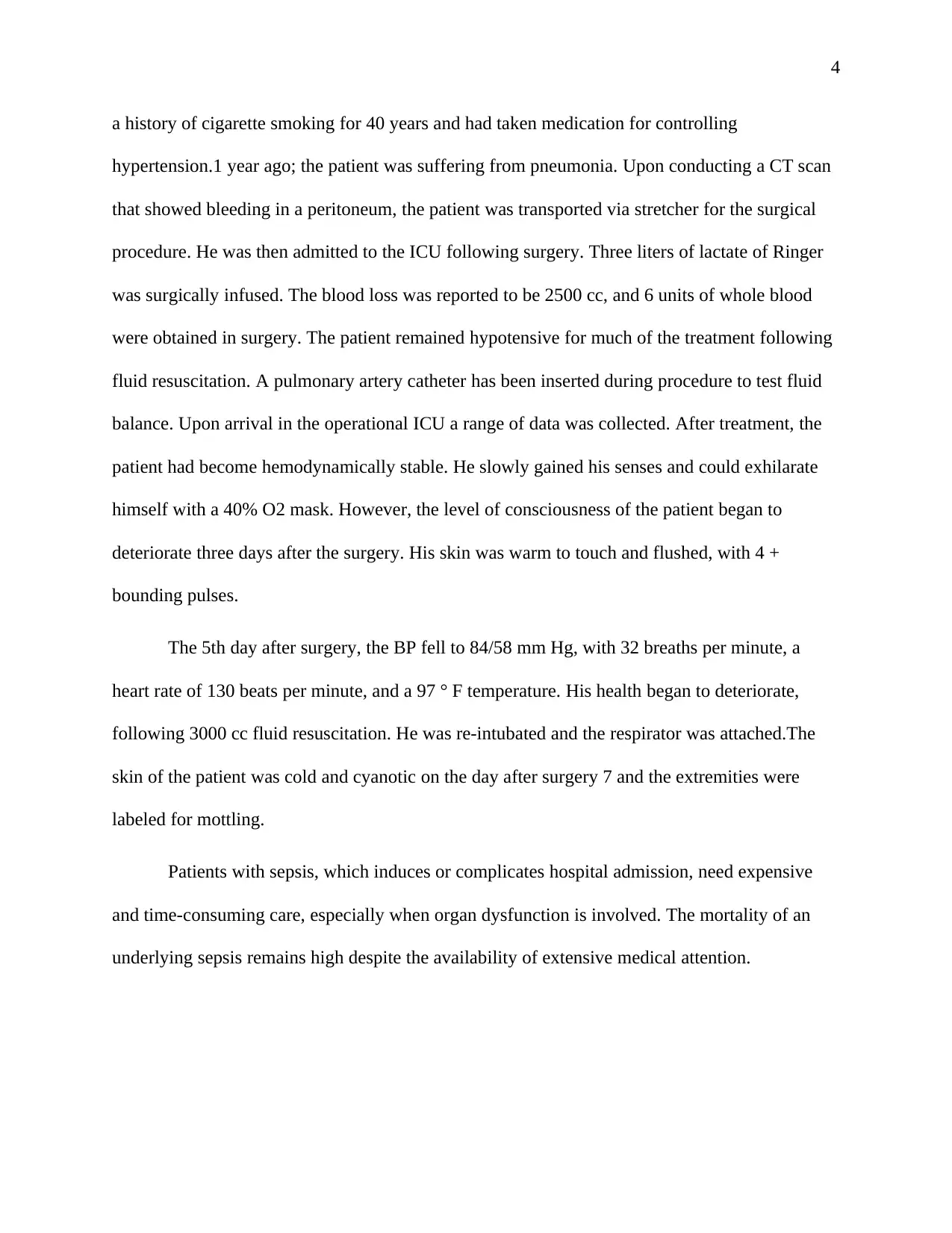
4
a history of cigarette smoking for 40 years and had taken medication for controlling
hypertension.1 year ago; the patient was suffering from pneumonia. Upon conducting a CT scan
that showed bleeding in a peritoneum, the patient was transported via stretcher for the surgical
procedure. He was then admitted to the ICU following surgery. Three liters of lactate of Ringer
was surgically infused. The blood loss was reported to be 2500 cc, and 6 units of whole blood
were obtained in surgery. The patient remained hypotensive for much of the treatment following
fluid resuscitation. A pulmonary artery catheter has been inserted during procedure to test fluid
balance. Upon arrival in the operational ICU a range of data was collected. After treatment, the
patient had become hemodynamically stable. He slowly gained his senses and could exhilarate
himself with a 40% O2 mask. However, the level of consciousness of the patient began to
deteriorate three days after the surgery. His skin was warm to touch and flushed, with 4 +
bounding pulses.
The 5th day after surgery, the BP fell to 84/58 mm Hg, with 32 breaths per minute, a
heart rate of 130 beats per minute, and a 97 ° F temperature. His health began to deteriorate,
following 3000 cc fluid resuscitation. He was re-intubated and the respirator was attached.The
skin of the patient was cold and cyanotic on the day after surgery 7 and the extremities were
labeled for mottling.
Patients with sepsis, which induces or complicates hospital admission, need expensive
and time-consuming care, especially when organ dysfunction is involved. The mortality of an
underlying sepsis remains high despite the availability of extensive medical attention.
a history of cigarette smoking for 40 years and had taken medication for controlling
hypertension.1 year ago; the patient was suffering from pneumonia. Upon conducting a CT scan
that showed bleeding in a peritoneum, the patient was transported via stretcher for the surgical
procedure. He was then admitted to the ICU following surgery. Three liters of lactate of Ringer
was surgically infused. The blood loss was reported to be 2500 cc, and 6 units of whole blood
were obtained in surgery. The patient remained hypotensive for much of the treatment following
fluid resuscitation. A pulmonary artery catheter has been inserted during procedure to test fluid
balance. Upon arrival in the operational ICU a range of data was collected. After treatment, the
patient had become hemodynamically stable. He slowly gained his senses and could exhilarate
himself with a 40% O2 mask. However, the level of consciousness of the patient began to
deteriorate three days after the surgery. His skin was warm to touch and flushed, with 4 +
bounding pulses.
The 5th day after surgery, the BP fell to 84/58 mm Hg, with 32 breaths per minute, a
heart rate of 130 beats per minute, and a 97 ° F temperature. His health began to deteriorate,
following 3000 cc fluid resuscitation. He was re-intubated and the respirator was attached.The
skin of the patient was cold and cyanotic on the day after surgery 7 and the extremities were
labeled for mottling.
Patients with sepsis, which induces or complicates hospital admission, need expensive
and time-consuming care, especially when organ dysfunction is involved. The mortality of an
underlying sepsis remains high despite the availability of extensive medical attention.
Secure Best Marks with AI Grader
Need help grading? Try our AI Grader for instant feedback on your assignments.
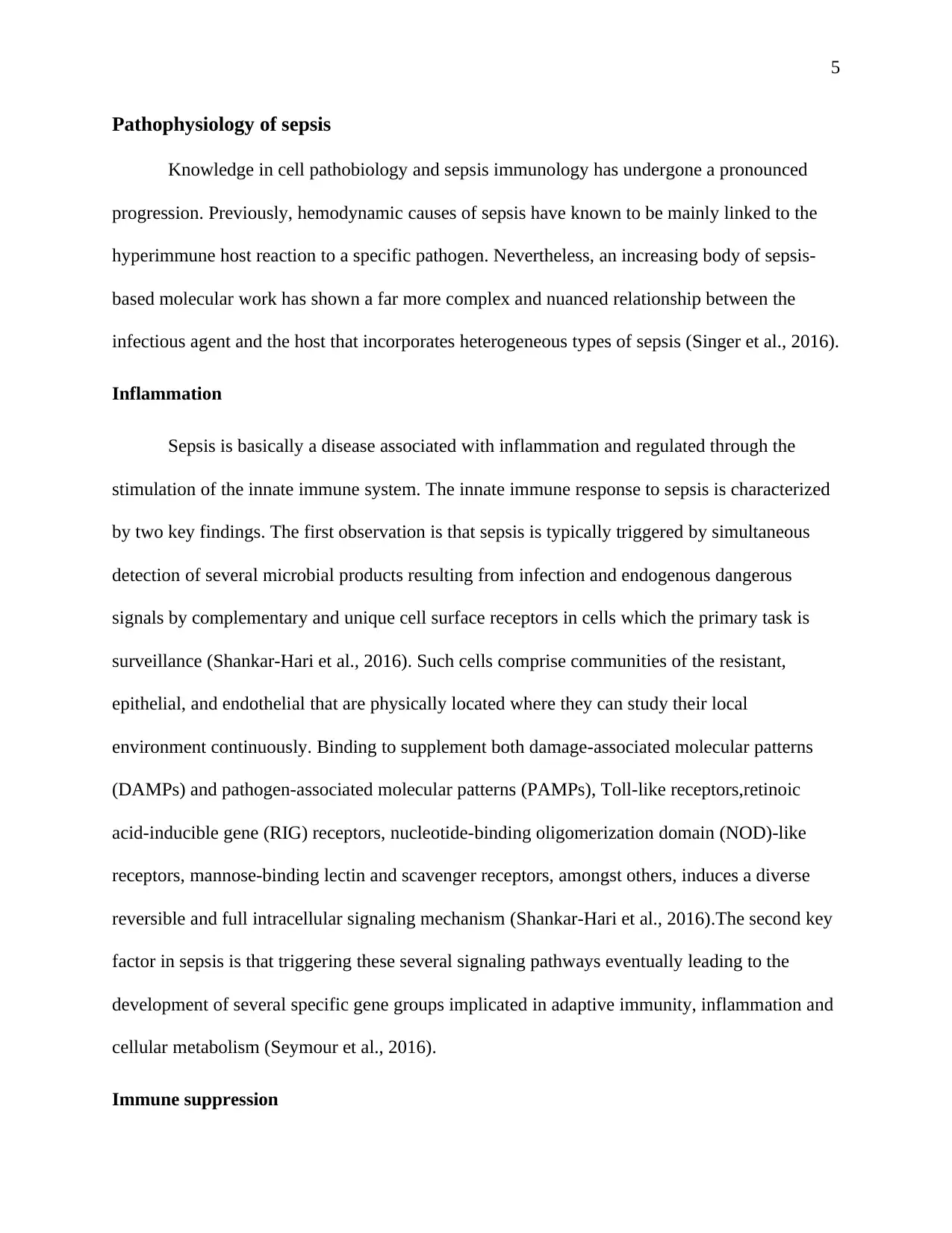
5
Pathophysiology of sepsis
Knowledge in cell pathobiology and sepsis immunology has undergone a pronounced
progression. Previously, hemodynamic causes of sepsis have known to be mainly linked to the
hyperimmune host reaction to a specific pathogen. Nevertheless, an increasing body of sepsis-
based molecular work has shown a far more complex and nuanced relationship between the
infectious agent and the host that incorporates heterogeneous types of sepsis (Singer et al., 2016).
Inflammation
Sepsis is basically a disease associated with inflammation and regulated through the
stimulation of the innate immune system. The innate immune response to sepsis is characterized
by two key findings. The first observation is that sepsis is typically triggered by simultaneous
detection of several microbial products resulting from infection and endogenous dangerous
signals by complementary and unique cell surface receptors in cells which the primary task is
surveillance (Shankar-Hari et al., 2016). Such cells comprise communities of the resistant,
epithelial, and endothelial that are physically located where they can study their local
environment continuously. Binding to supplement both damage-associated molecular patterns
(DAMPs) and pathogen-associated molecular patterns (PAMPs), Toll-like receptors,retinoic
acid-inducible gene (RIG) receptors, nucleotide-binding oligomerization domain (NOD)-like
receptors, mannose-binding lectin and scavenger receptors, amongst others, induces a diverse
reversible and full intracellular signaling mechanism (Shankar-Hari et al., 2016).The second key
factor in sepsis is that triggering these several signaling pathways eventually leading to the
development of several specific gene groups implicated in adaptive immunity, inflammation and
cellular metabolism (Seymour et al., 2016).
Immune suppression
Pathophysiology of sepsis
Knowledge in cell pathobiology and sepsis immunology has undergone a pronounced
progression. Previously, hemodynamic causes of sepsis have known to be mainly linked to the
hyperimmune host reaction to a specific pathogen. Nevertheless, an increasing body of sepsis-
based molecular work has shown a far more complex and nuanced relationship between the
infectious agent and the host that incorporates heterogeneous types of sepsis (Singer et al., 2016).
Inflammation
Sepsis is basically a disease associated with inflammation and regulated through the
stimulation of the innate immune system. The innate immune response to sepsis is characterized
by two key findings. The first observation is that sepsis is typically triggered by simultaneous
detection of several microbial products resulting from infection and endogenous dangerous
signals by complementary and unique cell surface receptors in cells which the primary task is
surveillance (Shankar-Hari et al., 2016). Such cells comprise communities of the resistant,
epithelial, and endothelial that are physically located where they can study their local
environment continuously. Binding to supplement both damage-associated molecular patterns
(DAMPs) and pathogen-associated molecular patterns (PAMPs), Toll-like receptors,retinoic
acid-inducible gene (RIG) receptors, nucleotide-binding oligomerization domain (NOD)-like
receptors, mannose-binding lectin and scavenger receptors, amongst others, induces a diverse
reversible and full intracellular signaling mechanism (Shankar-Hari et al., 2016).The second key
factor in sepsis is that triggering these several signaling pathways eventually leading to the
development of several specific gene groups implicated in adaptive immunity, inflammation and
cellular metabolism (Seymour et al., 2016).
Immune suppression
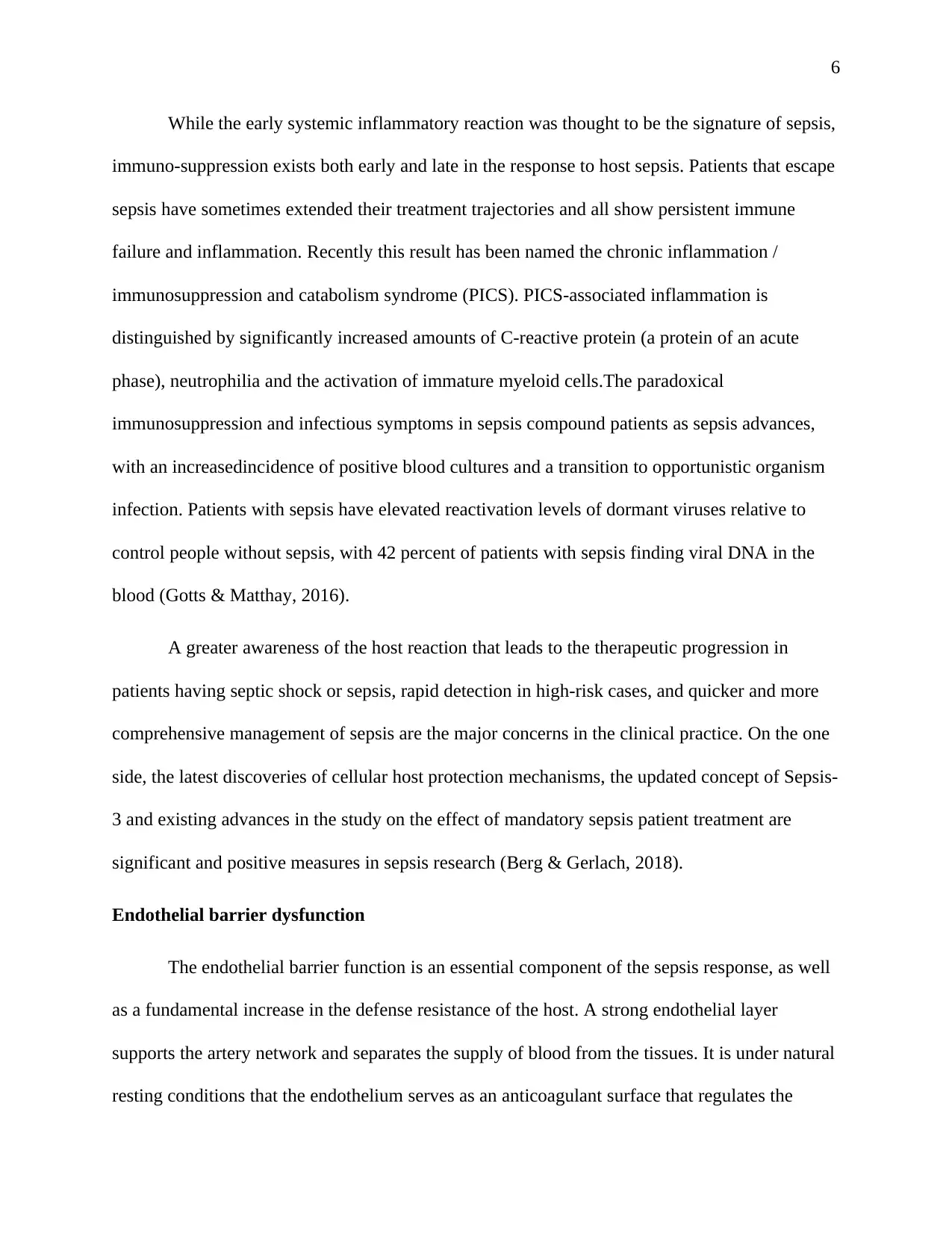
6
While the early systemic inflammatory reaction was thought to be the signature of sepsis,
immuno-suppression exists both early and late in the response to host sepsis. Patients that escape
sepsis have sometimes extended their treatment trajectories and all show persistent immune
failure and inflammation. Recently this result has been named the chronic inflammation /
immunosuppression and catabolism syndrome (PICS). PICS-associated inflammation is
distinguished by significantly increased amounts of C-reactive protein (a protein of an acute
phase), neutrophilia and the activation of immature myeloid cells.The paradoxical
immunosuppression and infectious symptoms in sepsis compound patients as sepsis advances,
with an increasedincidence of positive blood cultures and a transition to opportunistic organism
infection. Patients with sepsis have elevated reactivation levels of dormant viruses relative to
control people without sepsis, with 42 percent of patients with sepsis finding viral DNA in the
blood (Gotts & Matthay, 2016).
A greater awareness of the host reaction that leads to the therapeutic progression in
patients having septic shock or sepsis, rapid detection in high-risk cases, and quicker and more
comprehensive management of sepsis are the major concerns in the clinical practice. On the one
side, the latest discoveries of cellular host protection mechanisms, the updated concept of Sepsis-
3 and existing advances in the study on the effect of mandatory sepsis patient treatment are
significant and positive measures in sepsis research (Berg & Gerlach, 2018).
Endothelial barrier dysfunction
The endothelial barrier function is an essential component of the sepsis response, as well
as a fundamental increase in the defense resistance of the host. A strong endothelial layer
supports the artery network and separates the supply of blood from the tissues. It is under natural
resting conditions that the endothelium serves as an anticoagulant surface that regulates the
While the early systemic inflammatory reaction was thought to be the signature of sepsis,
immuno-suppression exists both early and late in the response to host sepsis. Patients that escape
sepsis have sometimes extended their treatment trajectories and all show persistent immune
failure and inflammation. Recently this result has been named the chronic inflammation /
immunosuppression and catabolism syndrome (PICS). PICS-associated inflammation is
distinguished by significantly increased amounts of C-reactive protein (a protein of an acute
phase), neutrophilia and the activation of immature myeloid cells.The paradoxical
immunosuppression and infectious symptoms in sepsis compound patients as sepsis advances,
with an increasedincidence of positive blood cultures and a transition to opportunistic organism
infection. Patients with sepsis have elevated reactivation levels of dormant viruses relative to
control people without sepsis, with 42 percent of patients with sepsis finding viral DNA in the
blood (Gotts & Matthay, 2016).
A greater awareness of the host reaction that leads to the therapeutic progression in
patients having septic shock or sepsis, rapid detection in high-risk cases, and quicker and more
comprehensive management of sepsis are the major concerns in the clinical practice. On the one
side, the latest discoveries of cellular host protection mechanisms, the updated concept of Sepsis-
3 and existing advances in the study on the effect of mandatory sepsis patient treatment are
significant and positive measures in sepsis research (Berg & Gerlach, 2018).
Endothelial barrier dysfunction
The endothelial barrier function is an essential component of the sepsis response, as well
as a fundamental increase in the defense resistance of the host. A strong endothelial layer
supports the artery network and separates the supply of blood from the tissues. It is under natural
resting conditions that the endothelium serves as an anticoagulant surface that regulates the
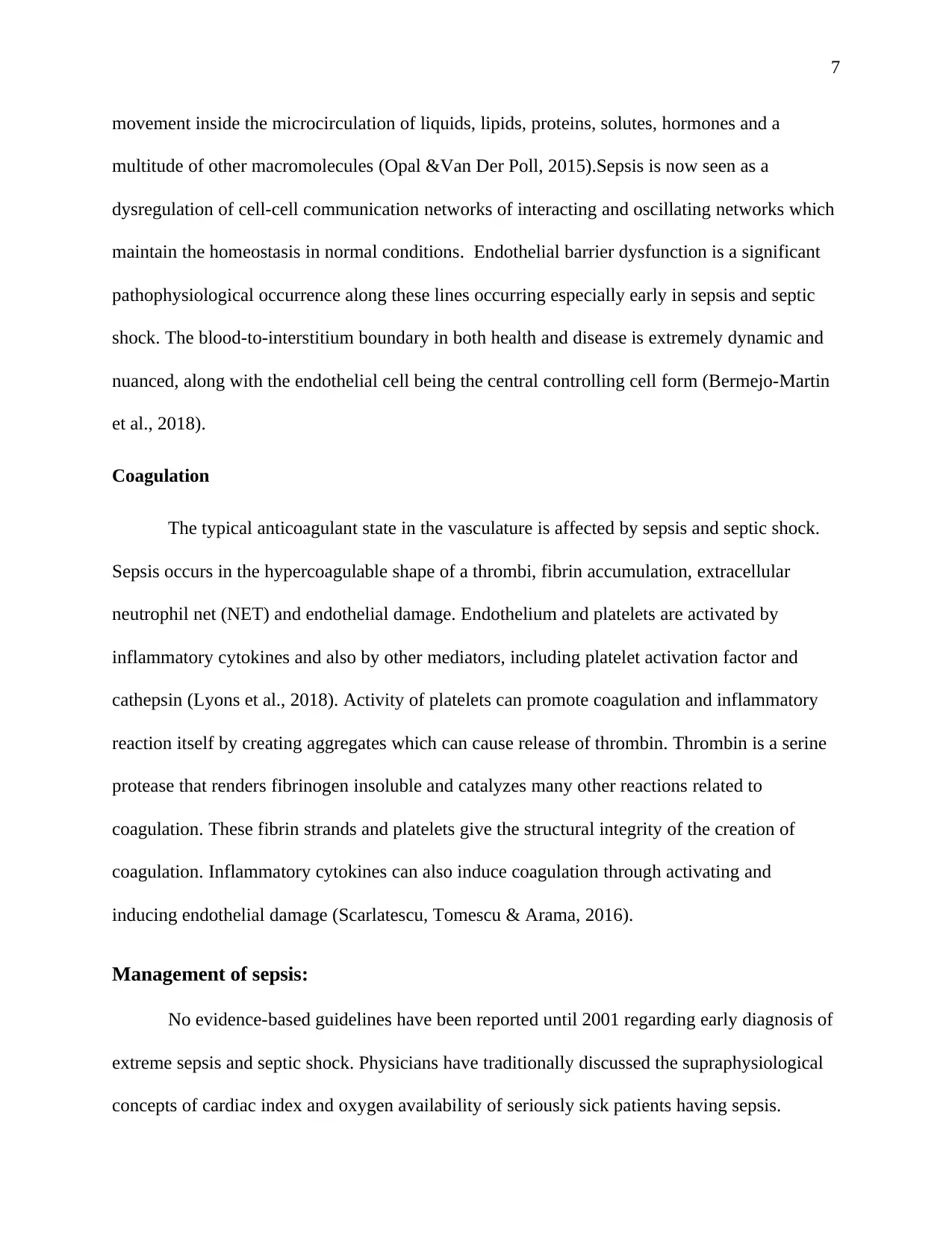
7
movement inside the microcirculation of liquids, lipids, proteins, solutes, hormones and a
multitude of other macromolecules (Opal &Van Der Poll, 2015).Sepsis is now seen as a
dysregulation of cell-cell communication networks of interacting and oscillating networks which
maintain the homeostasis in normal conditions. Endothelial barrier dysfunction is a significant
pathophysiological occurrence along these lines occurring especially early in sepsis and septic
shock. The blood-to-interstitium boundary in both health and disease is extremely dynamic and
nuanced, along with the endothelial cell being the central controlling cell form (Bermejo-Martin
et al., 2018).
Coagulation
The typical anticoagulant state in the vasculature is affected by sepsis and septic shock.
Sepsis occurs in the hypercoagulable shape of a thrombi, fibrin accumulation, extracellular
neutrophil net (NET) and endothelial damage. Endothelium and platelets are activated by
inflammatory cytokines and also by other mediators, including platelet activation factor and
cathepsin (Lyons et al., 2018). Activity of platelets can promote coagulation and inflammatory
reaction itself by creating aggregates which can cause release of thrombin. Thrombin is a serine
protease that renders fibrinogen insoluble and catalyzes many other reactions related to
coagulation. These fibrin strands and platelets give the structural integrity of the creation of
coagulation. Inflammatory cytokines can also induce coagulation through activating and
inducing endothelial damage (Scarlatescu, Tomescu & Arama, 2016).
Management of sepsis:
No evidence-based guidelines have been reported until 2001 regarding early diagnosis of
extreme sepsis and septic shock. Physicians have traditionally discussed the supraphysiological
concepts of cardiac index and oxygen availability of seriously sick patients having sepsis.
movement inside the microcirculation of liquids, lipids, proteins, solutes, hormones and a
multitude of other macromolecules (Opal &Van Der Poll, 2015).Sepsis is now seen as a
dysregulation of cell-cell communication networks of interacting and oscillating networks which
maintain the homeostasis in normal conditions. Endothelial barrier dysfunction is a significant
pathophysiological occurrence along these lines occurring especially early in sepsis and septic
shock. The blood-to-interstitium boundary in both health and disease is extremely dynamic and
nuanced, along with the endothelial cell being the central controlling cell form (Bermejo-Martin
et al., 2018).
Coagulation
The typical anticoagulant state in the vasculature is affected by sepsis and septic shock.
Sepsis occurs in the hypercoagulable shape of a thrombi, fibrin accumulation, extracellular
neutrophil net (NET) and endothelial damage. Endothelium and platelets are activated by
inflammatory cytokines and also by other mediators, including platelet activation factor and
cathepsin (Lyons et al., 2018). Activity of platelets can promote coagulation and inflammatory
reaction itself by creating aggregates which can cause release of thrombin. Thrombin is a serine
protease that renders fibrinogen insoluble and catalyzes many other reactions related to
coagulation. These fibrin strands and platelets give the structural integrity of the creation of
coagulation. Inflammatory cytokines can also induce coagulation through activating and
inducing endothelial damage (Scarlatescu, Tomescu & Arama, 2016).
Management of sepsis:
No evidence-based guidelines have been reported until 2001 regarding early diagnosis of
extreme sepsis and septic shock. Physicians have traditionally discussed the supraphysiological
concepts of cardiac index and oxygen availability of seriously sick patients having sepsis.
Paraphrase This Document
Need a fresh take? Get an instant paraphrase of this document with our AI Paraphraser
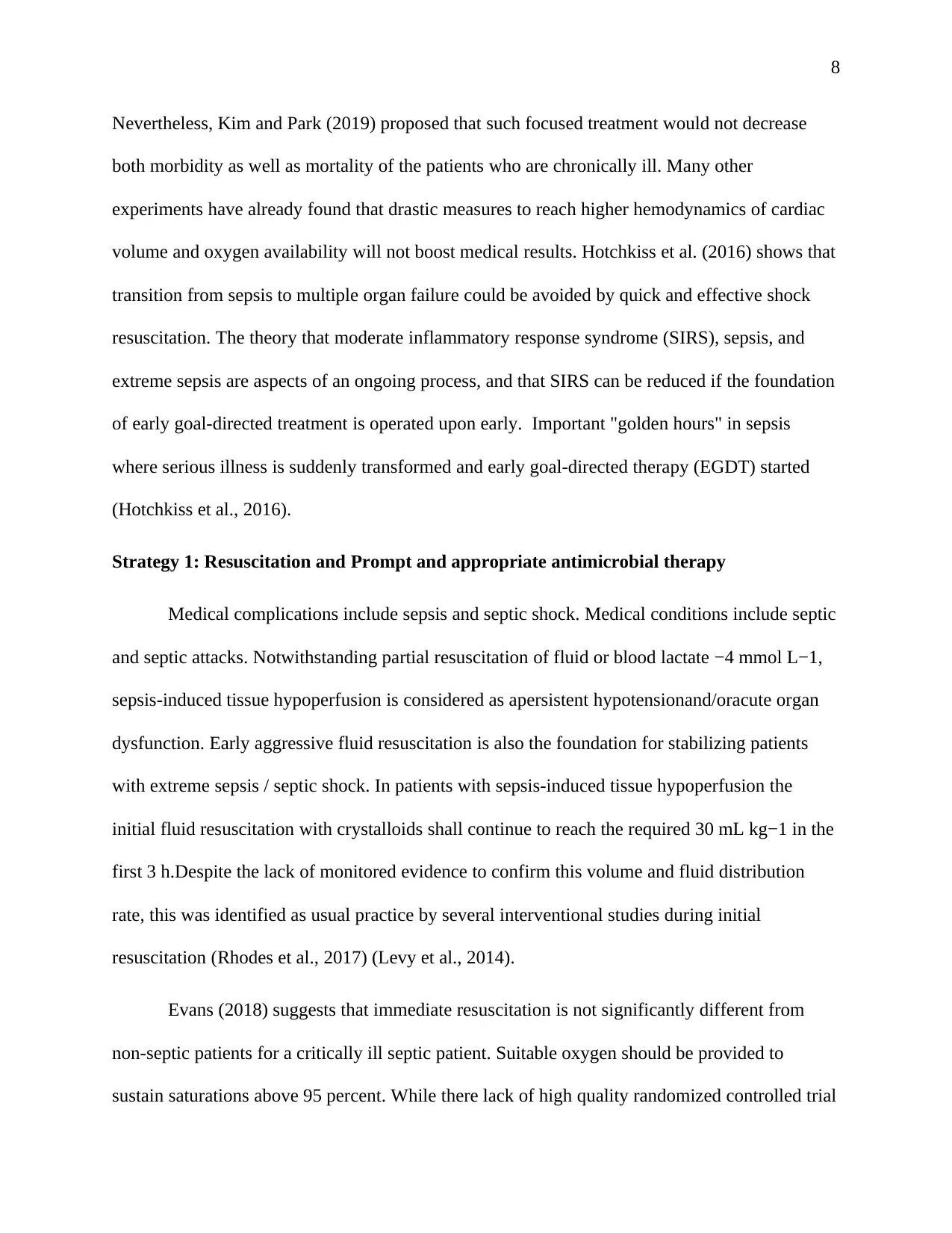
8
Nevertheless, Kim and Park (2019) proposed that such focused treatment would not decrease
both morbidity as well as mortality of the patients who are chronically ill. Many other
experiments have already found that drastic measures to reach higher hemodynamics of cardiac
volume and oxygen availability will not boost medical results. Hotchkiss et al. (2016) shows that
transition from sepsis to multiple organ failure could be avoided by quick and effective shock
resuscitation. The theory that moderate inflammatory response syndrome (SIRS), sepsis, and
extreme sepsis are aspects of an ongoing process, and that SIRS can be reduced if the foundation
of early goal-directed treatment is operated upon early. Important "golden hours" in sepsis
where serious illness is suddenly transformed and early goal-directed therapy (EGDT) started
(Hotchkiss et al., 2016).
Strategy 1: Resuscitation and Prompt and appropriate antimicrobial therapy
Medical complications include sepsis and septic shock. Medical conditions include septic
and septic attacks. Notwithstanding partial resuscitation of fluid or blood lactate −4 mmol L−1,
sepsis-induced tissue hypoperfusion is considered as apersistent hypotensionand/oracute organ
dysfunction. Early aggressive fluid resuscitation is also the foundation for stabilizing patients
with extreme sepsis / septic shock. In patients with sepsis-induced tissue hypoperfusion the
initial fluid resuscitation with crystalloids shall continue to reach the required 30 mL kg−1 in the
first 3 h.Despite the lack of monitored evidence to confirm this volume and fluid distribution
rate, this was identified as usual practice by several interventional studies during initial
resuscitation (Rhodes et al., 2017) (Levy et al., 2014).
Evans (2018) suggests that immediate resuscitation is not significantly different from
non-septic patients for a critically ill septic patient. Suitable oxygen should be provided to
sustain saturations above 95 percent. While there lack of high quality randomized controlled trial
Nevertheless, Kim and Park (2019) proposed that such focused treatment would not decrease
both morbidity as well as mortality of the patients who are chronically ill. Many other
experiments have already found that drastic measures to reach higher hemodynamics of cardiac
volume and oxygen availability will not boost medical results. Hotchkiss et al. (2016) shows that
transition from sepsis to multiple organ failure could be avoided by quick and effective shock
resuscitation. The theory that moderate inflammatory response syndrome (SIRS), sepsis, and
extreme sepsis are aspects of an ongoing process, and that SIRS can be reduced if the foundation
of early goal-directed treatment is operated upon early. Important "golden hours" in sepsis
where serious illness is suddenly transformed and early goal-directed therapy (EGDT) started
(Hotchkiss et al., 2016).
Strategy 1: Resuscitation and Prompt and appropriate antimicrobial therapy
Medical complications include sepsis and septic shock. Medical conditions include septic
and septic attacks. Notwithstanding partial resuscitation of fluid or blood lactate −4 mmol L−1,
sepsis-induced tissue hypoperfusion is considered as apersistent hypotensionand/oracute organ
dysfunction. Early aggressive fluid resuscitation is also the foundation for stabilizing patients
with extreme sepsis / septic shock. In patients with sepsis-induced tissue hypoperfusion the
initial fluid resuscitation with crystalloids shall continue to reach the required 30 mL kg−1 in the
first 3 h.Despite the lack of monitored evidence to confirm this volume and fluid distribution
rate, this was identified as usual practice by several interventional studies during initial
resuscitation (Rhodes et al., 2017) (Levy et al., 2014).
Evans (2018) suggests that immediate resuscitation is not significantly different from
non-septic patients for a critically ill septic patient. Suitable oxygen should be provided to
sustain saturations above 95 percent. While there lack of high quality randomized controlled trial
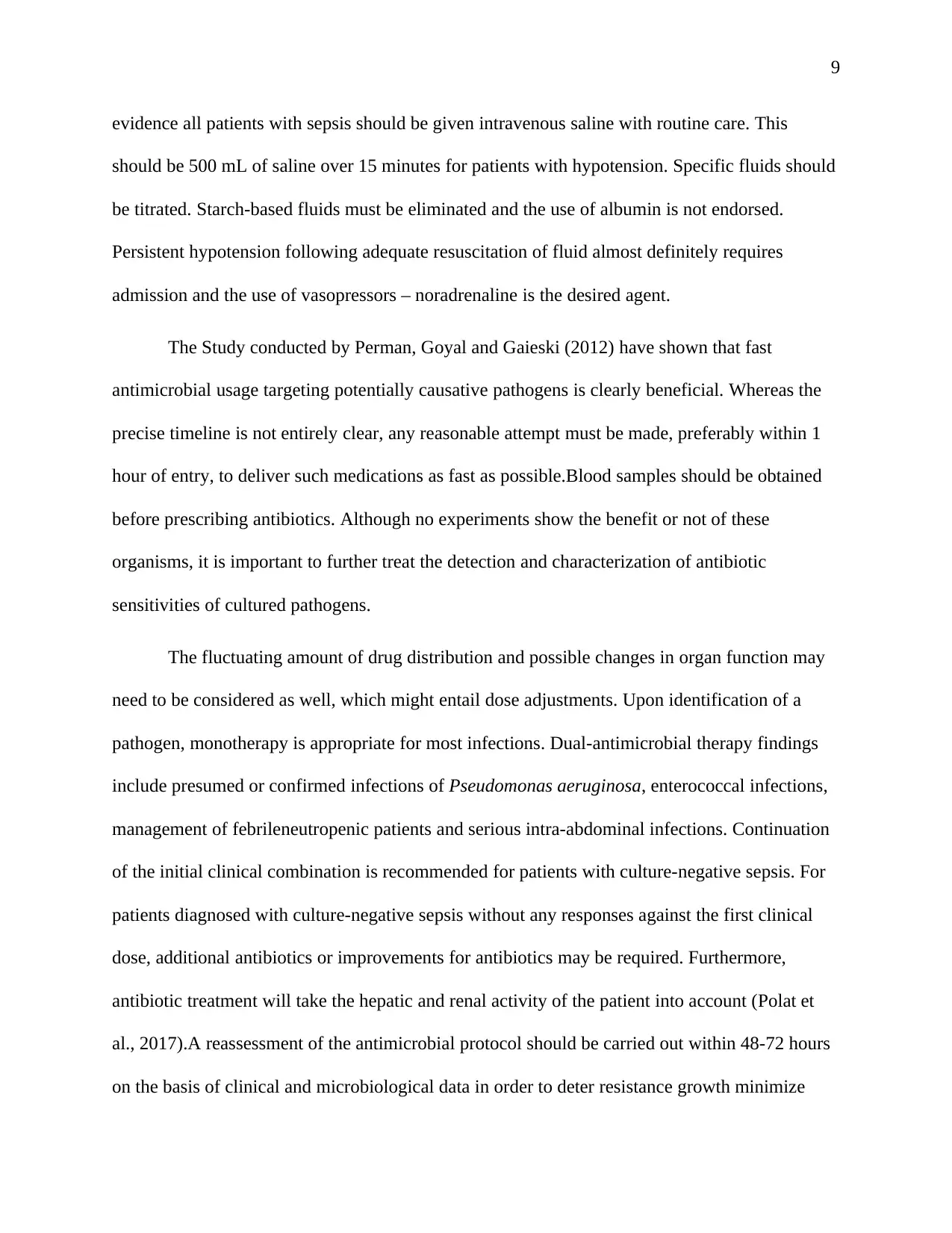
9
evidence all patients with sepsis should be given intravenous saline with routine care. This
should be 500 mL of saline over 15 minutes for patients with hypotension. Specific fluids should
be titrated. Starch-based fluids must be eliminated and the use of albumin is not endorsed.
Persistent hypotension following adequate resuscitation of fluid almost definitely requires
admission and the use of vasopressors – noradrenaline is the desired agent.
The Study conducted by Perman, Goyal and Gaieski (2012) have shown that fast
antimicrobial usage targeting potentially causative pathogens is clearly beneficial. Whereas the
precise timeline is not entirely clear, any reasonable attempt must be made, preferably within 1
hour of entry, to deliver such medications as fast as possible.Blood samples should be obtained
before prescribing antibiotics. Although no experiments show the benefit or not of these
organisms, it is important to further treat the detection and characterization of antibiotic
sensitivities of cultured pathogens.
The fluctuating amount of drug distribution and possible changes in organ function may
need to be considered as well, which might entail dose adjustments. Upon identification of a
pathogen, monotherapy is appropriate for most infections. Dual-antimicrobial therapy findings
include presumed or confirmed infections of Pseudomonas aeruginosa, enterococcal infections,
management of febrileneutropenic patients and serious intra-abdominal infections. Continuation
of the initial clinical combination is recommended for patients with culture-negative sepsis. For
patients diagnosed with culture-negative sepsis without any responses against the first clinical
dose, additional antibiotics or improvements for antibiotics may be required. Furthermore,
antibiotic treatment will take the hepatic and renal activity of the patient into account (Polat et
al., 2017).A reassessment of the antimicrobial protocol should be carried out within 48-72 hours
on the basis of clinical and microbiological data in order to deter resistance growth minimize
evidence all patients with sepsis should be given intravenous saline with routine care. This
should be 500 mL of saline over 15 minutes for patients with hypotension. Specific fluids should
be titrated. Starch-based fluids must be eliminated and the use of albumin is not endorsed.
Persistent hypotension following adequate resuscitation of fluid almost definitely requires
admission and the use of vasopressors – noradrenaline is the desired agent.
The Study conducted by Perman, Goyal and Gaieski (2012) have shown that fast
antimicrobial usage targeting potentially causative pathogens is clearly beneficial. Whereas the
precise timeline is not entirely clear, any reasonable attempt must be made, preferably within 1
hour of entry, to deliver such medications as fast as possible.Blood samples should be obtained
before prescribing antibiotics. Although no experiments show the benefit or not of these
organisms, it is important to further treat the detection and characterization of antibiotic
sensitivities of cultured pathogens.
The fluctuating amount of drug distribution and possible changes in organ function may
need to be considered as well, which might entail dose adjustments. Upon identification of a
pathogen, monotherapy is appropriate for most infections. Dual-antimicrobial therapy findings
include presumed or confirmed infections of Pseudomonas aeruginosa, enterococcal infections,
management of febrileneutropenic patients and serious intra-abdominal infections. Continuation
of the initial clinical combination is recommended for patients with culture-negative sepsis. For
patients diagnosed with culture-negative sepsis without any responses against the first clinical
dose, additional antibiotics or improvements for antibiotics may be required. Furthermore,
antibiotic treatment will take the hepatic and renal activity of the patient into account (Polat et
al., 2017).A reassessment of the antimicrobial protocol should be carried out within 48-72 hours
on the basis of clinical and microbiological data in order to deter resistance growth minimize
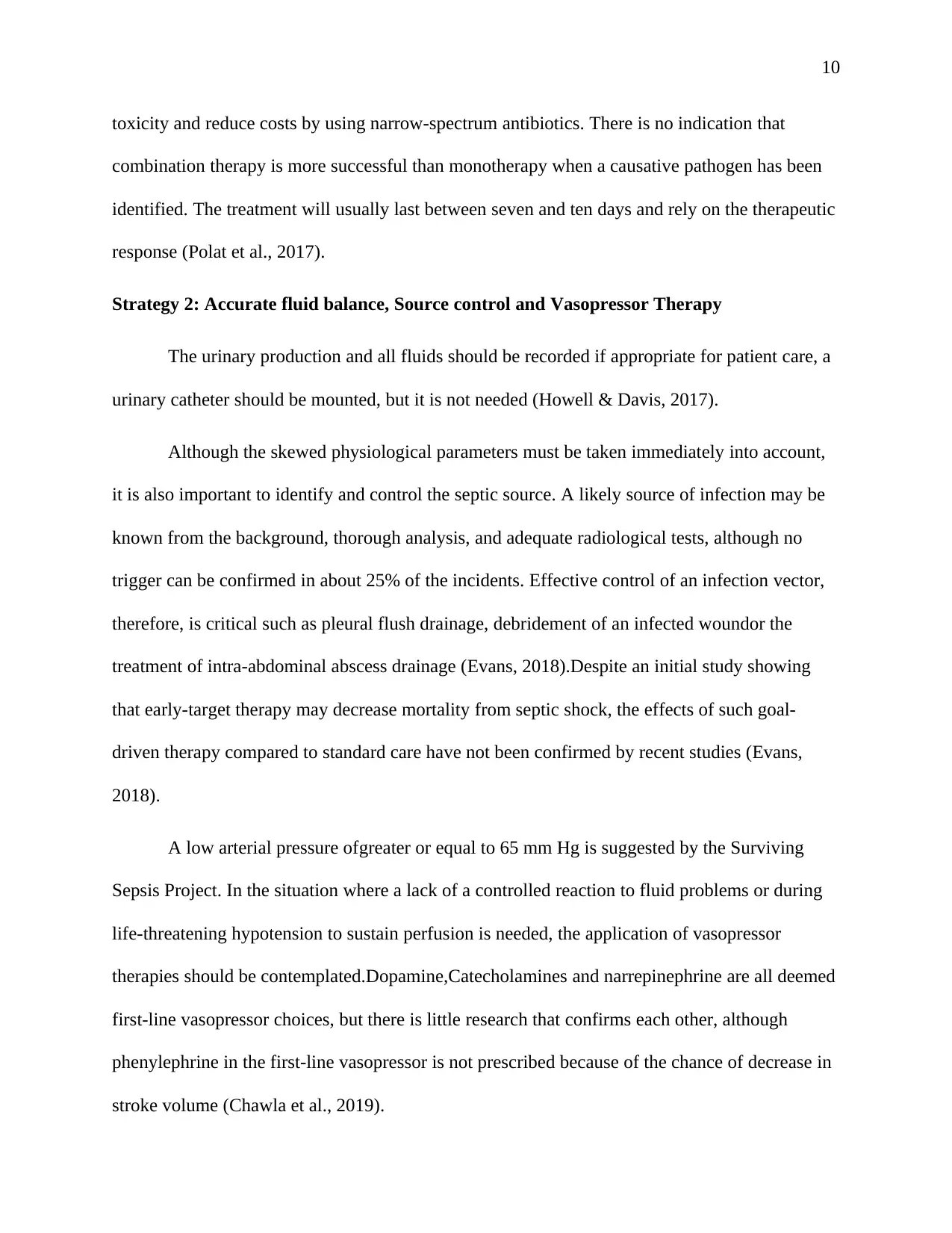
10
toxicity and reduce costs by using narrow-spectrum antibiotics. There is no indication that
combination therapy is more successful than monotherapy when a causative pathogen has been
identified. The treatment will usually last between seven and ten days and rely on the therapeutic
response (Polat et al., 2017).
Strategy 2: Accurate fluid balance, Source control and Vasopressor Therapy
The urinary production and all fluids should be recorded if appropriate for patient care, a
urinary catheter should be mounted, but it is not needed (Howell & Davis, 2017).
Although the skewed physiological parameters must be taken immediately into account,
it is also important to identify and control the septic source. A likely source of infection may be
known from the background, thorough analysis, and adequate radiological tests, although no
trigger can be confirmed in about 25% of the incidents. Effective control of an infection vector,
therefore, is critical such as pleural flush drainage, debridement of an infected woundor the
treatment of intra-abdominal abscess drainage (Evans, 2018).Despite an initial study showing
that early-target therapy may decrease mortality from septic shock, the effects of such goal-
driven therapy compared to standard care have not been confirmed by recent studies (Evans,
2018).
A low arterial pressure ofgreater or equal to 65 mm Hg is suggested by the Surviving
Sepsis Project. In the situation where a lack of a controlled reaction to fluid problems or during
life-threatening hypotension to sustain perfusion is needed, the application of vasopressor
therapies should be contemplated.Dopamine,Catecholamines and narrepinephrine are all deemed
first-line vasopressor choices, but there is little research that confirms each other, although
phenylephrine in the first-line vasopressor is not prescribed because of the chance of decrease in
stroke volume (Chawla et al., 2019).
toxicity and reduce costs by using narrow-spectrum antibiotics. There is no indication that
combination therapy is more successful than monotherapy when a causative pathogen has been
identified. The treatment will usually last between seven and ten days and rely on the therapeutic
response (Polat et al., 2017).
Strategy 2: Accurate fluid balance, Source control and Vasopressor Therapy
The urinary production and all fluids should be recorded if appropriate for patient care, a
urinary catheter should be mounted, but it is not needed (Howell & Davis, 2017).
Although the skewed physiological parameters must be taken immediately into account,
it is also important to identify and control the septic source. A likely source of infection may be
known from the background, thorough analysis, and adequate radiological tests, although no
trigger can be confirmed in about 25% of the incidents. Effective control of an infection vector,
therefore, is critical such as pleural flush drainage, debridement of an infected woundor the
treatment of intra-abdominal abscess drainage (Evans, 2018).Despite an initial study showing
that early-target therapy may decrease mortality from septic shock, the effects of such goal-
driven therapy compared to standard care have not been confirmed by recent studies (Evans,
2018).
A low arterial pressure ofgreater or equal to 65 mm Hg is suggested by the Surviving
Sepsis Project. In the situation where a lack of a controlled reaction to fluid problems or during
life-threatening hypotension to sustain perfusion is needed, the application of vasopressor
therapies should be contemplated.Dopamine,Catecholamines and narrepinephrine are all deemed
first-line vasopressor choices, but there is little research that confirms each other, although
phenylephrine in the first-line vasopressor is not prescribed because of the chance of decrease in
stroke volume (Chawla et al., 2019).
Secure Best Marks with AI Grader
Need help grading? Try our AI Grader for instant feedback on your assignments.
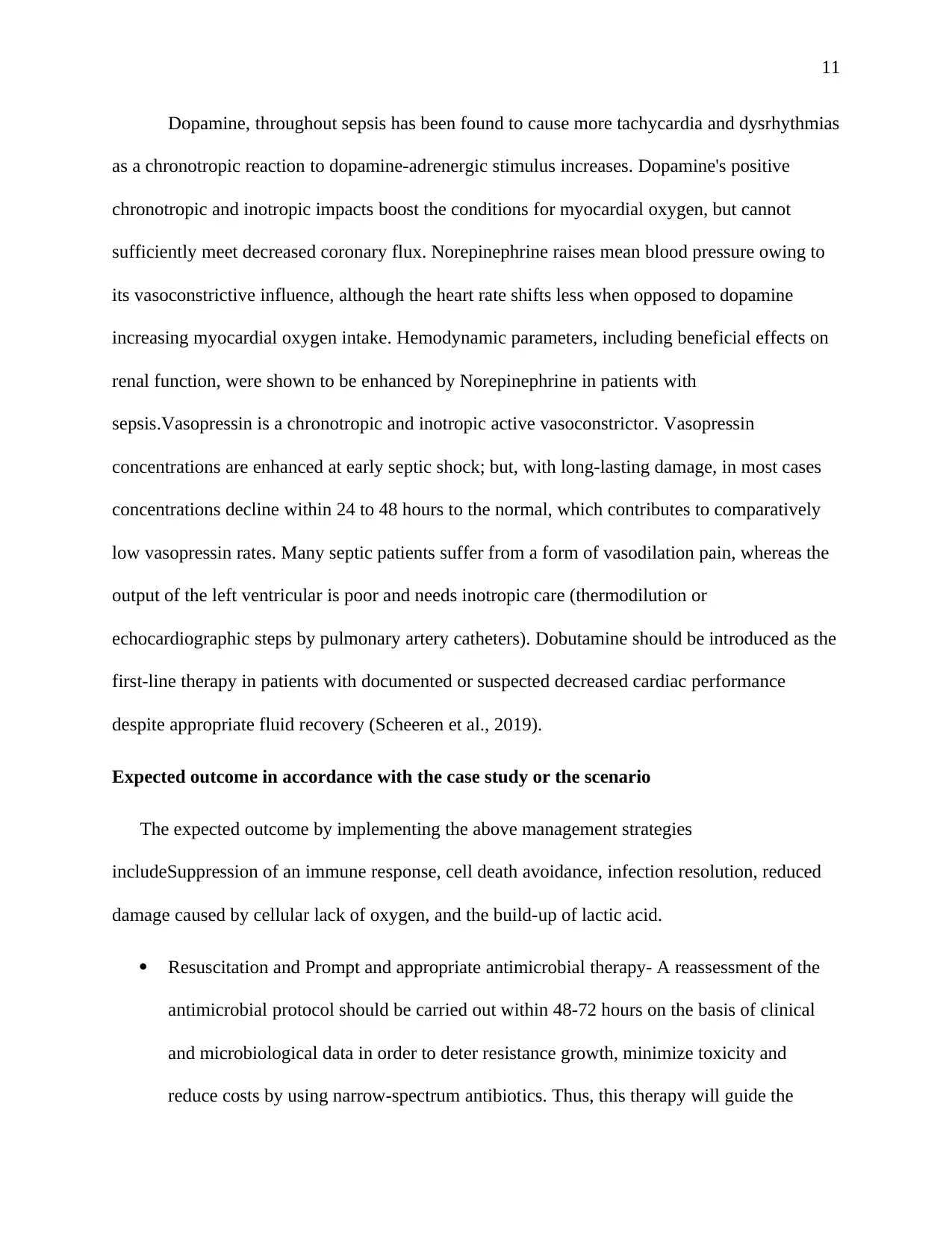
11
Dopamine, throughout sepsis has been found to cause more tachycardia and dysrhythmias
as a chronotropic reaction to dopamine-adrenergic stimulus increases. Dopamine's positive
chronotropic and inotropic impacts boost the conditions for myocardial oxygen, but cannot
sufficiently meet decreased coronary flux. Norepinephrine raises mean blood pressure owing to
its vasoconstrictive influence, although the heart rate shifts less when opposed to dopamine
increasing myocardial oxygen intake. Hemodynamic parameters, including beneficial effects on
renal function, were shown to be enhanced by Norepinephrine in patients with
sepsis.Vasopressin is a chronotropic and inotropic active vasoconstrictor. Vasopressin
concentrations are enhanced at early septic shock; but, with long-lasting damage, in most cases
concentrations decline within 24 to 48 hours to the normal, which contributes to comparatively
low vasopressin rates. Many septic patients suffer from a form of vasodilation pain, whereas the
output of the left ventricular is poor and needs inotropic care (thermodilution or
echocardiographic steps by pulmonary artery catheters). Dobutamine should be introduced as the
first-line therapy in patients with documented or suspected decreased cardiac performance
despite appropriate fluid recovery (Scheeren et al., 2019).
Expected outcome in accordance with the case study or the scenario
The expected outcome by implementing the above management strategies
includeSuppression of an immune response, cell death avoidance, infection resolution, reduced
damage caused by cellular lack of oxygen, and the build-up of lactic acid.
Resuscitation and Prompt and appropriate antimicrobial therapy- A reassessment of the
antimicrobial protocol should be carried out within 48-72 hours on the basis of clinical
and microbiological data in order to deter resistance growth, minimize toxicity and
reduce costs by using narrow-spectrum antibiotics. Thus, this therapy will guide the
Dopamine, throughout sepsis has been found to cause more tachycardia and dysrhythmias
as a chronotropic reaction to dopamine-adrenergic stimulus increases. Dopamine's positive
chronotropic and inotropic impacts boost the conditions for myocardial oxygen, but cannot
sufficiently meet decreased coronary flux. Norepinephrine raises mean blood pressure owing to
its vasoconstrictive influence, although the heart rate shifts less when opposed to dopamine
increasing myocardial oxygen intake. Hemodynamic parameters, including beneficial effects on
renal function, were shown to be enhanced by Norepinephrine in patients with
sepsis.Vasopressin is a chronotropic and inotropic active vasoconstrictor. Vasopressin
concentrations are enhanced at early septic shock; but, with long-lasting damage, in most cases
concentrations decline within 24 to 48 hours to the normal, which contributes to comparatively
low vasopressin rates. Many septic patients suffer from a form of vasodilation pain, whereas the
output of the left ventricular is poor and needs inotropic care (thermodilution or
echocardiographic steps by pulmonary artery catheters). Dobutamine should be introduced as the
first-line therapy in patients with documented or suspected decreased cardiac performance
despite appropriate fluid recovery (Scheeren et al., 2019).
Expected outcome in accordance with the case study or the scenario
The expected outcome by implementing the above management strategies
includeSuppression of an immune response, cell death avoidance, infection resolution, reduced
damage caused by cellular lack of oxygen, and the build-up of lactic acid.
Resuscitation and Prompt and appropriate antimicrobial therapy- A reassessment of the
antimicrobial protocol should be carried out within 48-72 hours on the basis of clinical
and microbiological data in order to deter resistance growth, minimize toxicity and
reduce costs by using narrow-spectrum antibiotics. Thus, this therapy will guide the
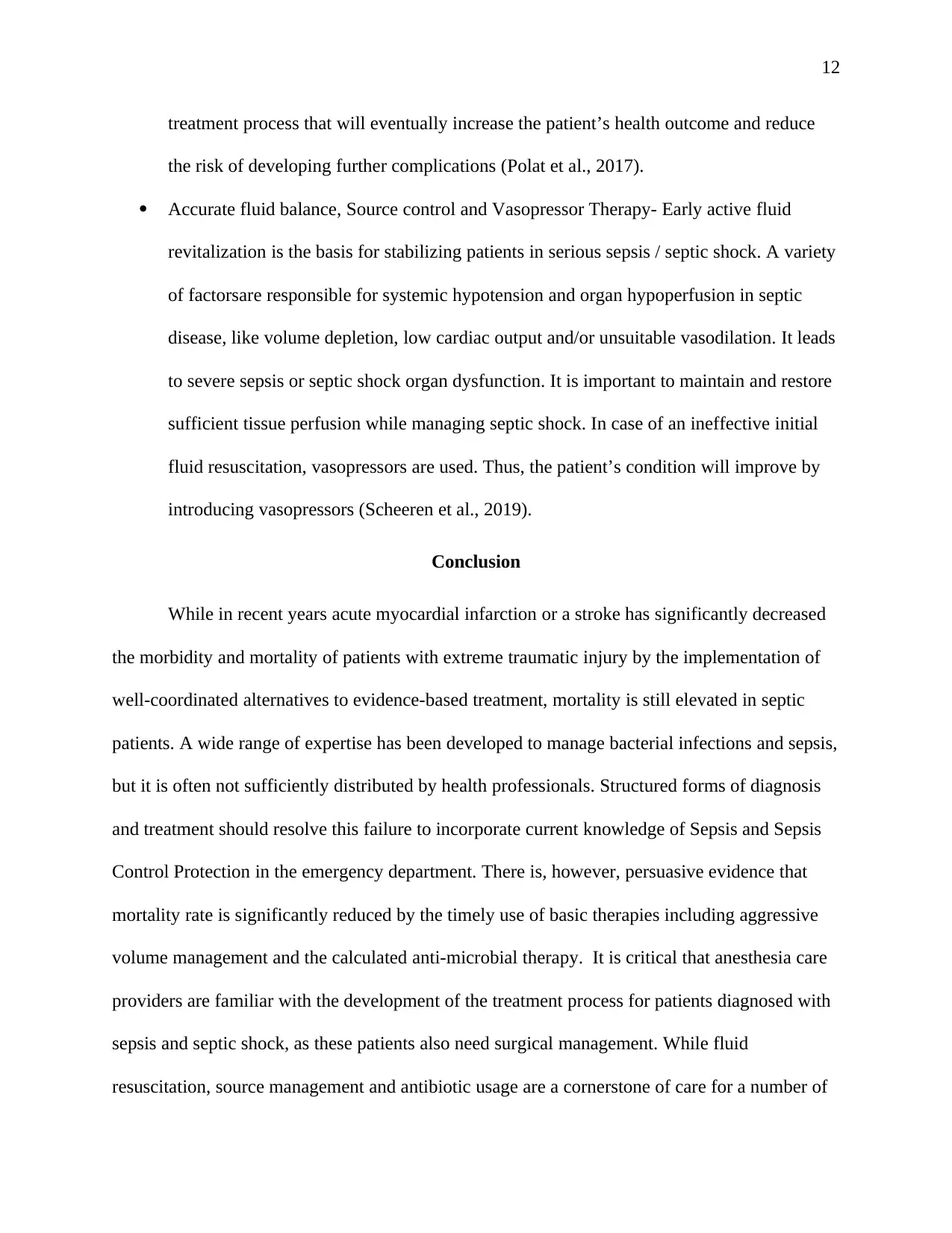
12
treatment process that will eventually increase the patient’s health outcome and reduce
the risk of developing further complications (Polat et al., 2017).
Accurate fluid balance, Source control and Vasopressor Therapy- Early active fluid
revitalization is the basis for stabilizing patients in serious sepsis / septic shock. A variety
of factorsare responsible for systemic hypotension and organ hypoperfusion in septic
disease, like volume depletion, low cardiac output and/or unsuitable vasodilation. It leads
to severe sepsis or septic shock organ dysfunction. It is important to maintain and restore
sufficient tissue perfusion while managing septic shock. In case of an ineffective initial
fluid resuscitation, vasopressors are used. Thus, the patient’s condition will improve by
introducing vasopressors (Scheeren et al., 2019).
Conclusion
While in recent years acute myocardial infarction or a stroke has significantly decreased
the morbidity and mortality of patients with extreme traumatic injury by the implementation of
well-coordinated alternatives to evidence-based treatment, mortality is still elevated in septic
patients. A wide range of expertise has been developed to manage bacterial infections and sepsis,
but it is often not sufficiently distributed by health professionals. Structured forms of diagnosis
and treatment should resolve this failure to incorporate current knowledge of Sepsis and Sepsis
Control Protection in the emergency department. There is, however, persuasive evidence that
mortality rate is significantly reduced by the timely use of basic therapies including aggressive
volume management and the calculated anti-microbial therapy. It is critical that anesthesia care
providers are familiar with the development of the treatment process for patients diagnosed with
sepsis and septic shock, as these patients also need surgical management. While fluid
resuscitation, source management and antibiotic usage are a cornerstone of care for a number of
treatment process that will eventually increase the patient’s health outcome and reduce
the risk of developing further complications (Polat et al., 2017).
Accurate fluid balance, Source control and Vasopressor Therapy- Early active fluid
revitalization is the basis for stabilizing patients in serious sepsis / septic shock. A variety
of factorsare responsible for systemic hypotension and organ hypoperfusion in septic
disease, like volume depletion, low cardiac output and/or unsuitable vasodilation. It leads
to severe sepsis or septic shock organ dysfunction. It is important to maintain and restore
sufficient tissue perfusion while managing septic shock. In case of an ineffective initial
fluid resuscitation, vasopressors are used. Thus, the patient’s condition will improve by
introducing vasopressors (Scheeren et al., 2019).
Conclusion
While in recent years acute myocardial infarction or a stroke has significantly decreased
the morbidity and mortality of patients with extreme traumatic injury by the implementation of
well-coordinated alternatives to evidence-based treatment, mortality is still elevated in septic
patients. A wide range of expertise has been developed to manage bacterial infections and sepsis,
but it is often not sufficiently distributed by health professionals. Structured forms of diagnosis
and treatment should resolve this failure to incorporate current knowledge of Sepsis and Sepsis
Control Protection in the emergency department. There is, however, persuasive evidence that
mortality rate is significantly reduced by the timely use of basic therapies including aggressive
volume management and the calculated anti-microbial therapy. It is critical that anesthesia care
providers are familiar with the development of the treatment process for patients diagnosed with
sepsis and septic shock, as these patients also need surgical management. While fluid
resuscitation, source management and antibiotic usage are a cornerstone of care for a number of

13
years, such therapies and other medications have been grouped into' bundles' that have been
promising to minimize morbidity and mortality, such as early aim therapy, serum lactate
screening, use of rhAPC and low-dose corticosteroids, glycemia regulation.
years, such therapies and other medications have been grouped into' bundles' that have been
promising to minimize morbidity and mortality, such as early aim therapy, serum lactate
screening, use of rhAPC and low-dose corticosteroids, glycemia regulation.
Paraphrase This Document
Need a fresh take? Get an instant paraphrase of this document with our AI Paraphraser
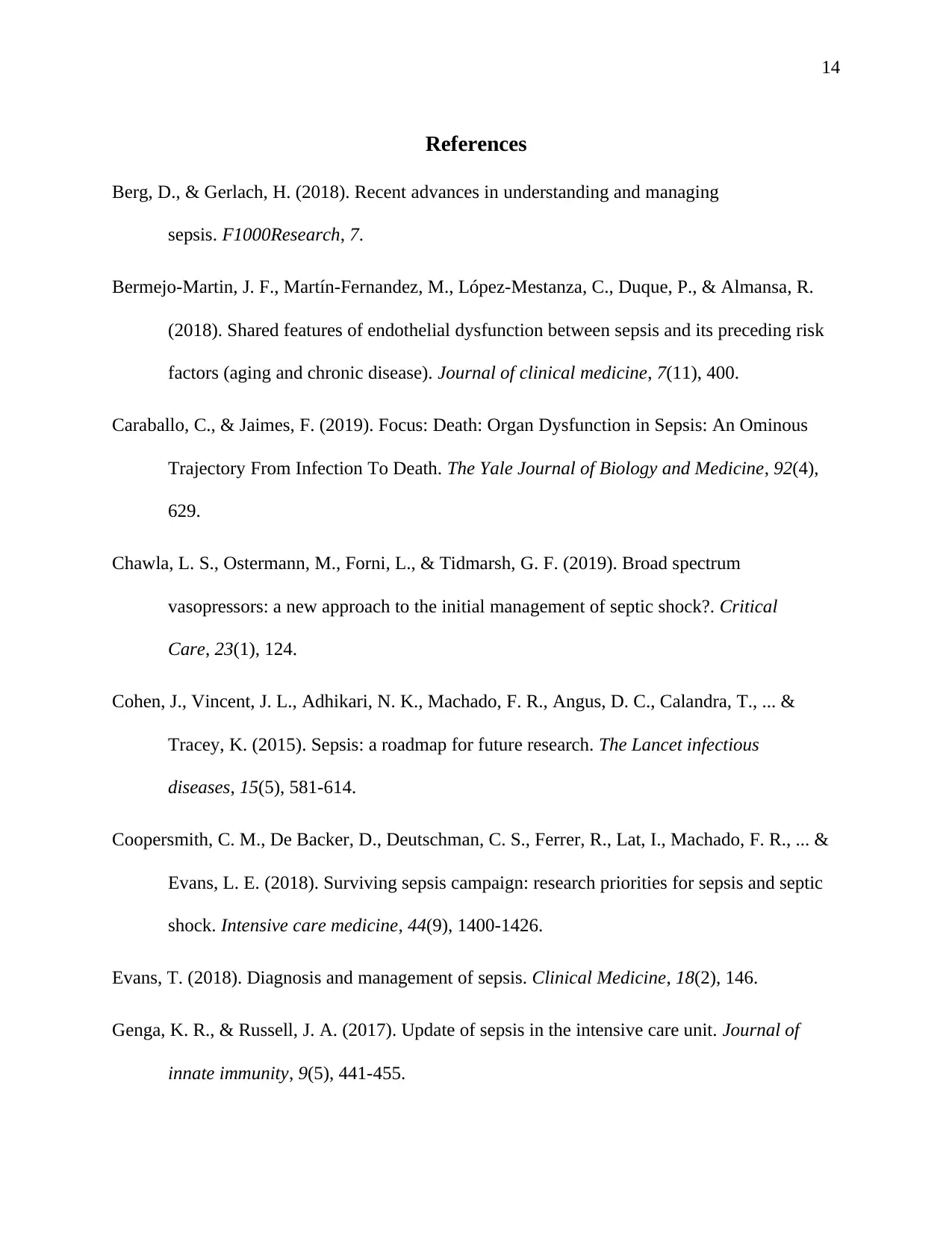
14
References
Berg, D., & Gerlach, H. (2018). Recent advances in understanding and managing
sepsis. F1000Research, 7.
Bermejo-Martin, J. F., Martín-Fernandez, M., López-Mestanza, C., Duque, P., & Almansa, R.
(2018). Shared features of endothelial dysfunction between sepsis and its preceding risk
factors (aging and chronic disease). Journal of clinical medicine, 7(11), 400.
Caraballo, C., & Jaimes, F. (2019). Focus: Death: Organ Dysfunction in Sepsis: An Ominous
Trajectory From Infection To Death. The Yale Journal of Biology and Medicine, 92(4),
629.
Chawla, L. S., Ostermann, M., Forni, L., & Tidmarsh, G. F. (2019). Broad spectrum
vasopressors: a new approach to the initial management of septic shock?. Critical
Care, 23(1), 124.
Cohen, J., Vincent, J. L., Adhikari, N. K., Machado, F. R., Angus, D. C., Calandra, T., ... &
Tracey, K. (2015). Sepsis: a roadmap for future research. The Lancet infectious
diseases, 15(5), 581-614.
Coopersmith, C. M., De Backer, D., Deutschman, C. S., Ferrer, R., Lat, I., Machado, F. R., ... &
Evans, L. E. (2018). Surviving sepsis campaign: research priorities for sepsis and septic
shock. Intensive care medicine, 44(9), 1400-1426.
Evans, T. (2018). Diagnosis and management of sepsis. Clinical Medicine, 18(2), 146.
Genga, K. R., & Russell, J. A. (2017). Update of sepsis in the intensive care unit. Journal of
innate immunity, 9(5), 441-455.
References
Berg, D., & Gerlach, H. (2018). Recent advances in understanding and managing
sepsis. F1000Research, 7.
Bermejo-Martin, J. F., Martín-Fernandez, M., López-Mestanza, C., Duque, P., & Almansa, R.
(2018). Shared features of endothelial dysfunction between sepsis and its preceding risk
factors (aging and chronic disease). Journal of clinical medicine, 7(11), 400.
Caraballo, C., & Jaimes, F. (2019). Focus: Death: Organ Dysfunction in Sepsis: An Ominous
Trajectory From Infection To Death. The Yale Journal of Biology and Medicine, 92(4),
629.
Chawla, L. S., Ostermann, M., Forni, L., & Tidmarsh, G. F. (2019). Broad spectrum
vasopressors: a new approach to the initial management of septic shock?. Critical
Care, 23(1), 124.
Cohen, J., Vincent, J. L., Adhikari, N. K., Machado, F. R., Angus, D. C., Calandra, T., ... &
Tracey, K. (2015). Sepsis: a roadmap for future research. The Lancet infectious
diseases, 15(5), 581-614.
Coopersmith, C. M., De Backer, D., Deutschman, C. S., Ferrer, R., Lat, I., Machado, F. R., ... &
Evans, L. E. (2018). Surviving sepsis campaign: research priorities for sepsis and septic
shock. Intensive care medicine, 44(9), 1400-1426.
Evans, T. (2018). Diagnosis and management of sepsis. Clinical Medicine, 18(2), 146.
Genga, K. R., & Russell, J. A. (2017). Update of sepsis in the intensive care unit. Journal of
innate immunity, 9(5), 441-455.
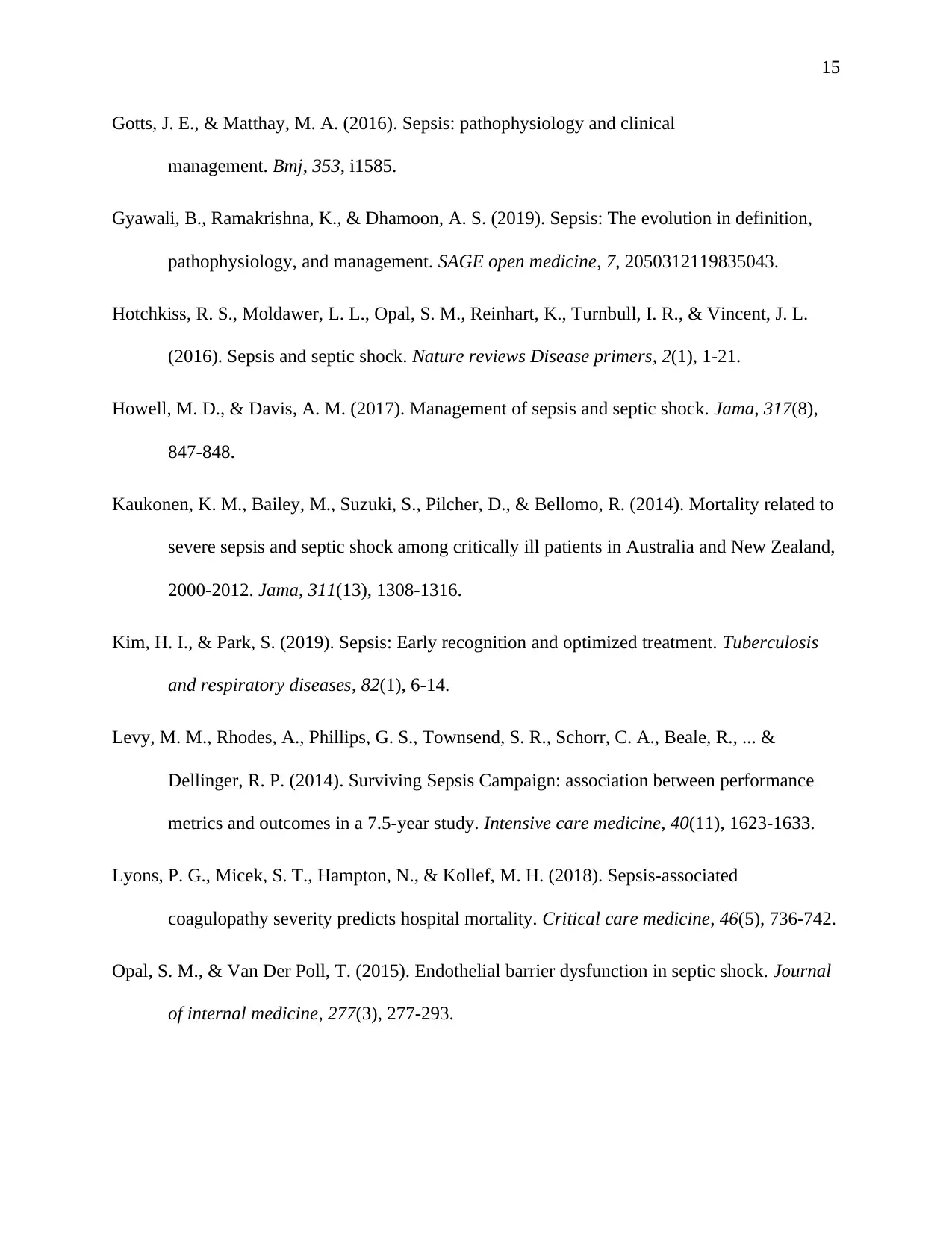
15
Gotts, J. E., & Matthay, M. A. (2016). Sepsis: pathophysiology and clinical
management. Bmj, 353, i1585.
Gyawali, B., Ramakrishna, K., & Dhamoon, A. S. (2019). Sepsis: The evolution in definition,
pathophysiology, and management. SAGE open medicine, 7, 2050312119835043.
Hotchkiss, R. S., Moldawer, L. L., Opal, S. M., Reinhart, K., Turnbull, I. R., & Vincent, J. L.
(2016). Sepsis and septic shock. Nature reviews Disease primers, 2(1), 1-21.
Howell, M. D., & Davis, A. M. (2017). Management of sepsis and septic shock. Jama, 317(8),
847-848.
Kaukonen, K. M., Bailey, M., Suzuki, S., Pilcher, D., & Bellomo, R. (2014). Mortality related to
severe sepsis and septic shock among critically ill patients in Australia and New Zealand,
2000-2012. Jama, 311(13), 1308-1316.
Kim, H. I., & Park, S. (2019). Sepsis: Early recognition and optimized treatment. Tuberculosis
and respiratory diseases, 82(1), 6-14.
Levy, M. M., Rhodes, A., Phillips, G. S., Townsend, S. R., Schorr, C. A., Beale, R., ... &
Dellinger, R. P. (2014). Surviving Sepsis Campaign: association between performance
metrics and outcomes in a 7.5-year study. Intensive care medicine, 40(11), 1623-1633.
Lyons, P. G., Micek, S. T., Hampton, N., & Kollef, M. H. (2018). Sepsis-associated
coagulopathy severity predicts hospital mortality. Critical care medicine, 46(5), 736-742.
Opal, S. M., & Van Der Poll, T. (2015). Endothelial barrier dysfunction in septic shock. Journal
of internal medicine, 277(3), 277-293.
Gotts, J. E., & Matthay, M. A. (2016). Sepsis: pathophysiology and clinical
management. Bmj, 353, i1585.
Gyawali, B., Ramakrishna, K., & Dhamoon, A. S. (2019). Sepsis: The evolution in definition,
pathophysiology, and management. SAGE open medicine, 7, 2050312119835043.
Hotchkiss, R. S., Moldawer, L. L., Opal, S. M., Reinhart, K., Turnbull, I. R., & Vincent, J. L.
(2016). Sepsis and septic shock. Nature reviews Disease primers, 2(1), 1-21.
Howell, M. D., & Davis, A. M. (2017). Management of sepsis and septic shock. Jama, 317(8),
847-848.
Kaukonen, K. M., Bailey, M., Suzuki, S., Pilcher, D., & Bellomo, R. (2014). Mortality related to
severe sepsis and septic shock among critically ill patients in Australia and New Zealand,
2000-2012. Jama, 311(13), 1308-1316.
Kim, H. I., & Park, S. (2019). Sepsis: Early recognition and optimized treatment. Tuberculosis
and respiratory diseases, 82(1), 6-14.
Levy, M. M., Rhodes, A., Phillips, G. S., Townsend, S. R., Schorr, C. A., Beale, R., ... &
Dellinger, R. P. (2014). Surviving Sepsis Campaign: association between performance
metrics and outcomes in a 7.5-year study. Intensive care medicine, 40(11), 1623-1633.
Lyons, P. G., Micek, S. T., Hampton, N., & Kollef, M. H. (2018). Sepsis-associated
coagulopathy severity predicts hospital mortality. Critical care medicine, 46(5), 736-742.
Opal, S. M., & Van Der Poll, T. (2015). Endothelial barrier dysfunction in septic shock. Journal
of internal medicine, 277(3), 277-293.
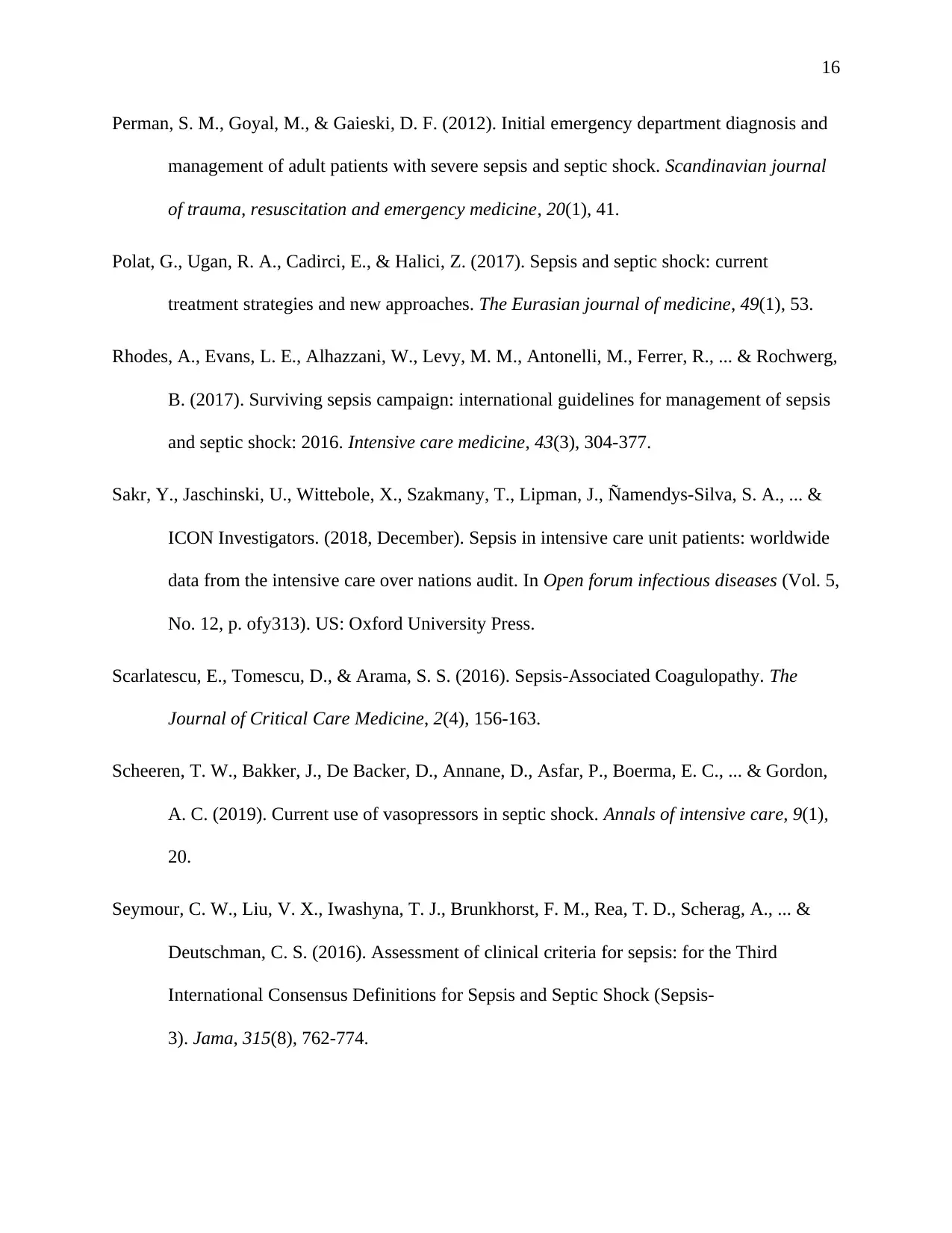
16
Perman, S. M., Goyal, M., & Gaieski, D. F. (2012). Initial emergency department diagnosis and
management of adult patients with severe sepsis and septic shock. Scandinavian journal
of trauma, resuscitation and emergency medicine, 20(1), 41.
Polat, G., Ugan, R. A., Cadirci, E., & Halici, Z. (2017). Sepsis and septic shock: current
treatment strategies and new approaches. The Eurasian journal of medicine, 49(1), 53.
Rhodes, A., Evans, L. E., Alhazzani, W., Levy, M. M., Antonelli, M., Ferrer, R., ... & Rochwerg,
B. (2017). Surviving sepsis campaign: international guidelines for management of sepsis
and septic shock: 2016. Intensive care medicine, 43(3), 304-377.
Sakr, Y., Jaschinski, U., Wittebole, X., Szakmany, T., Lipman, J., Ñamendys-Silva, S. A., ... &
ICON Investigators. (2018, December). Sepsis in intensive care unit patients: worldwide
data from the intensive care over nations audit. In Open forum infectious diseases (Vol. 5,
No. 12, p. ofy313). US: Oxford University Press.
Scarlatescu, E., Tomescu, D., & Arama, S. S. (2016). Sepsis-Associated Coagulopathy. The
Journal of Critical Care Medicine, 2(4), 156-163.
Scheeren, T. W., Bakker, J., De Backer, D., Annane, D., Asfar, P., Boerma, E. C., ... & Gordon,
A. C. (2019). Current use of vasopressors in septic shock. Annals of intensive care, 9(1),
20.
Seymour, C. W., Liu, V. X., Iwashyna, T. J., Brunkhorst, F. M., Rea, T. D., Scherag, A., ... &
Deutschman, C. S. (2016). Assessment of clinical criteria for sepsis: for the Third
International Consensus Definitions for Sepsis and Septic Shock (Sepsis-
3). Jama, 315(8), 762-774.
Perman, S. M., Goyal, M., & Gaieski, D. F. (2012). Initial emergency department diagnosis and
management of adult patients with severe sepsis and septic shock. Scandinavian journal
of trauma, resuscitation and emergency medicine, 20(1), 41.
Polat, G., Ugan, R. A., Cadirci, E., & Halici, Z. (2017). Sepsis and septic shock: current
treatment strategies and new approaches. The Eurasian journal of medicine, 49(1), 53.
Rhodes, A., Evans, L. E., Alhazzani, W., Levy, M. M., Antonelli, M., Ferrer, R., ... & Rochwerg,
B. (2017). Surviving sepsis campaign: international guidelines for management of sepsis
and septic shock: 2016. Intensive care medicine, 43(3), 304-377.
Sakr, Y., Jaschinski, U., Wittebole, X., Szakmany, T., Lipman, J., Ñamendys-Silva, S. A., ... &
ICON Investigators. (2018, December). Sepsis in intensive care unit patients: worldwide
data from the intensive care over nations audit. In Open forum infectious diseases (Vol. 5,
No. 12, p. ofy313). US: Oxford University Press.
Scarlatescu, E., Tomescu, D., & Arama, S. S. (2016). Sepsis-Associated Coagulopathy. The
Journal of Critical Care Medicine, 2(4), 156-163.
Scheeren, T. W., Bakker, J., De Backer, D., Annane, D., Asfar, P., Boerma, E. C., ... & Gordon,
A. C. (2019). Current use of vasopressors in septic shock. Annals of intensive care, 9(1),
20.
Seymour, C. W., Liu, V. X., Iwashyna, T. J., Brunkhorst, F. M., Rea, T. D., Scherag, A., ... &
Deutschman, C. S. (2016). Assessment of clinical criteria for sepsis: for the Third
International Consensus Definitions for Sepsis and Septic Shock (Sepsis-
3). Jama, 315(8), 762-774.
Secure Best Marks with AI Grader
Need help grading? Try our AI Grader for instant feedback on your assignments.
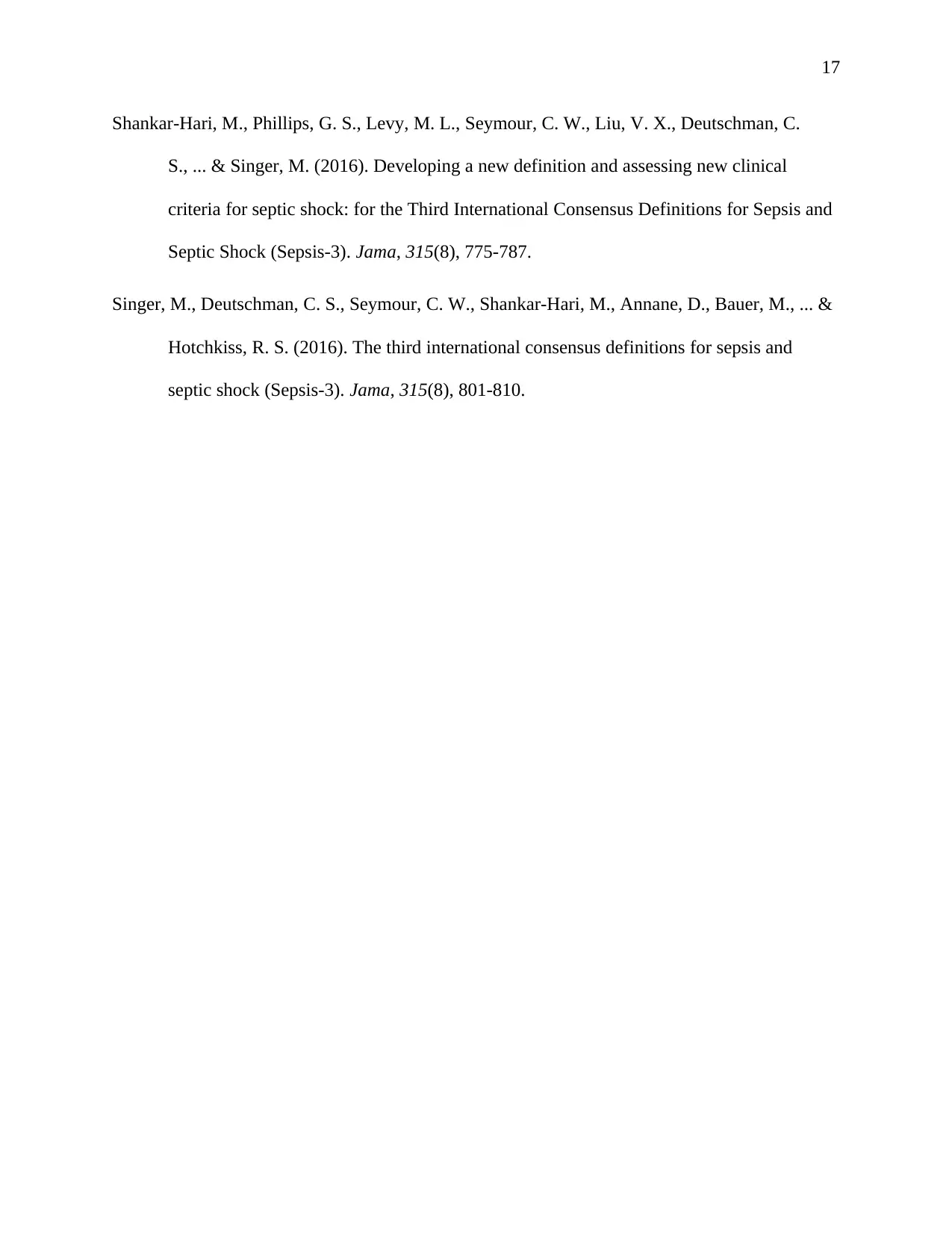
17
Shankar-Hari, M., Phillips, G. S., Levy, M. L., Seymour, C. W., Liu, V. X., Deutschman, C.
S., ... & Singer, M. (2016). Developing a new definition and assessing new clinical
criteria for septic shock: for the Third International Consensus Definitions for Sepsis and
Septic Shock (Sepsis-3). Jama, 315(8), 775-787.
Singer, M., Deutschman, C. S., Seymour, C. W., Shankar-Hari, M., Annane, D., Bauer, M., ... &
Hotchkiss, R. S. (2016). The third international consensus definitions for sepsis and
septic shock (Sepsis-3). Jama, 315(8), 801-810.
Shankar-Hari, M., Phillips, G. S., Levy, M. L., Seymour, C. W., Liu, V. X., Deutschman, C.
S., ... & Singer, M. (2016). Developing a new definition and assessing new clinical
criteria for septic shock: for the Third International Consensus Definitions for Sepsis and
Septic Shock (Sepsis-3). Jama, 315(8), 775-787.
Singer, M., Deutschman, C. S., Seymour, C. W., Shankar-Hari, M., Annane, D., Bauer, M., ... &
Hotchkiss, R. S. (2016). The third international consensus definitions for sepsis and
septic shock (Sepsis-3). Jama, 315(8), 801-810.
1 out of 17
Related Documents
Your All-in-One AI-Powered Toolkit for Academic Success.
+13062052269
info@desklib.com
Available 24*7 on WhatsApp / Email
![[object Object]](/_next/static/media/star-bottom.7253800d.svg)
Unlock your academic potential
© 2024 | Zucol Services PVT LTD | All rights reserved.





